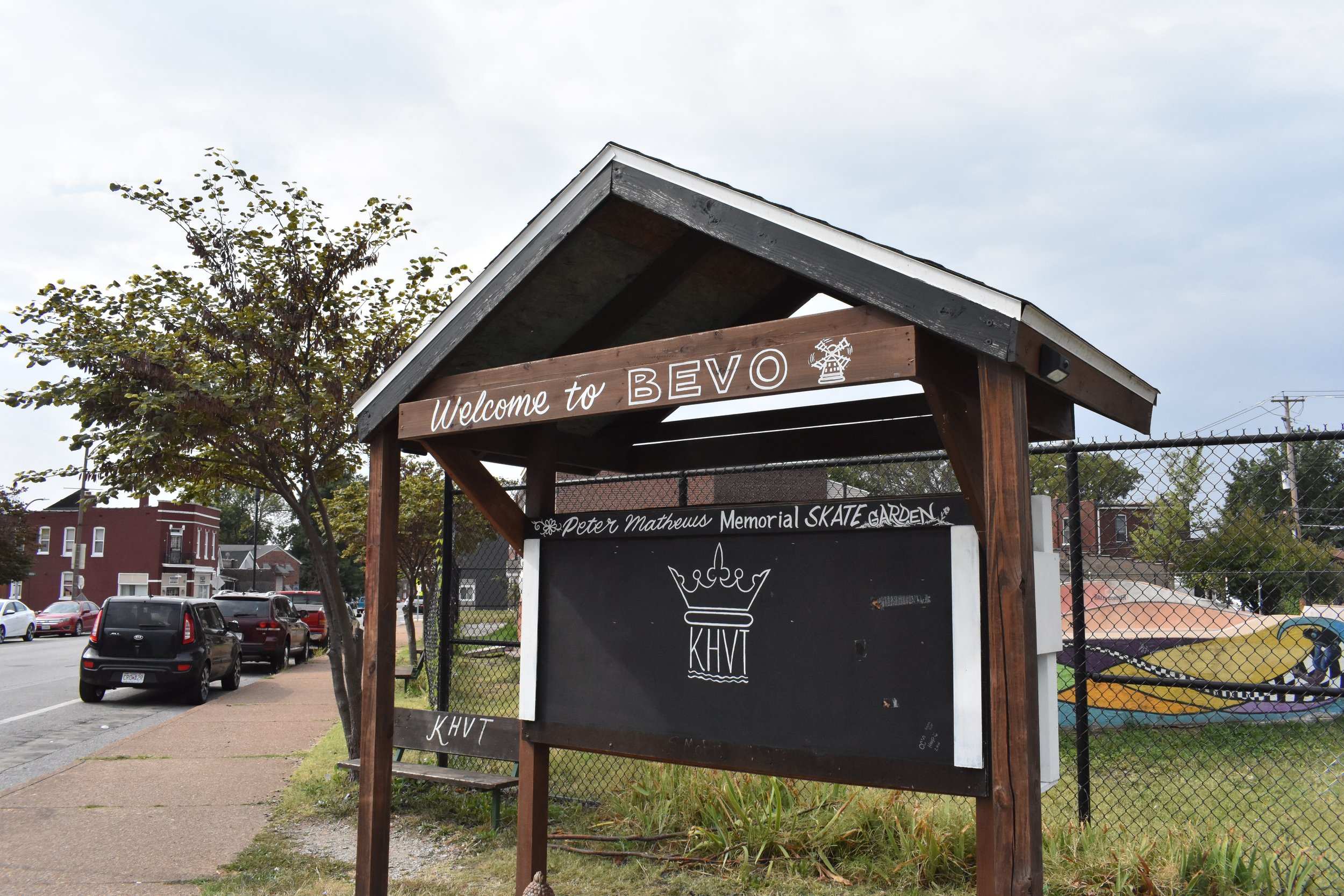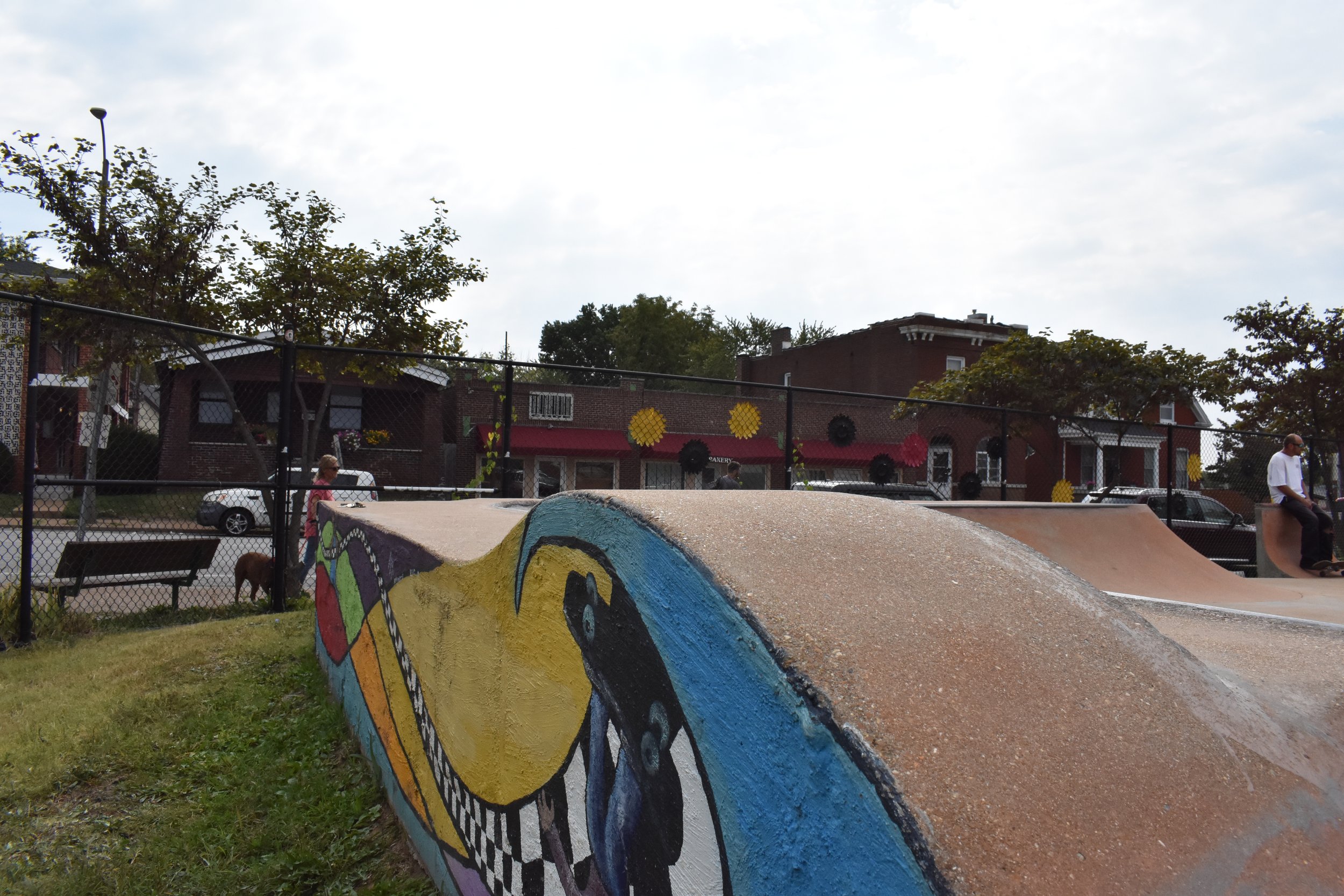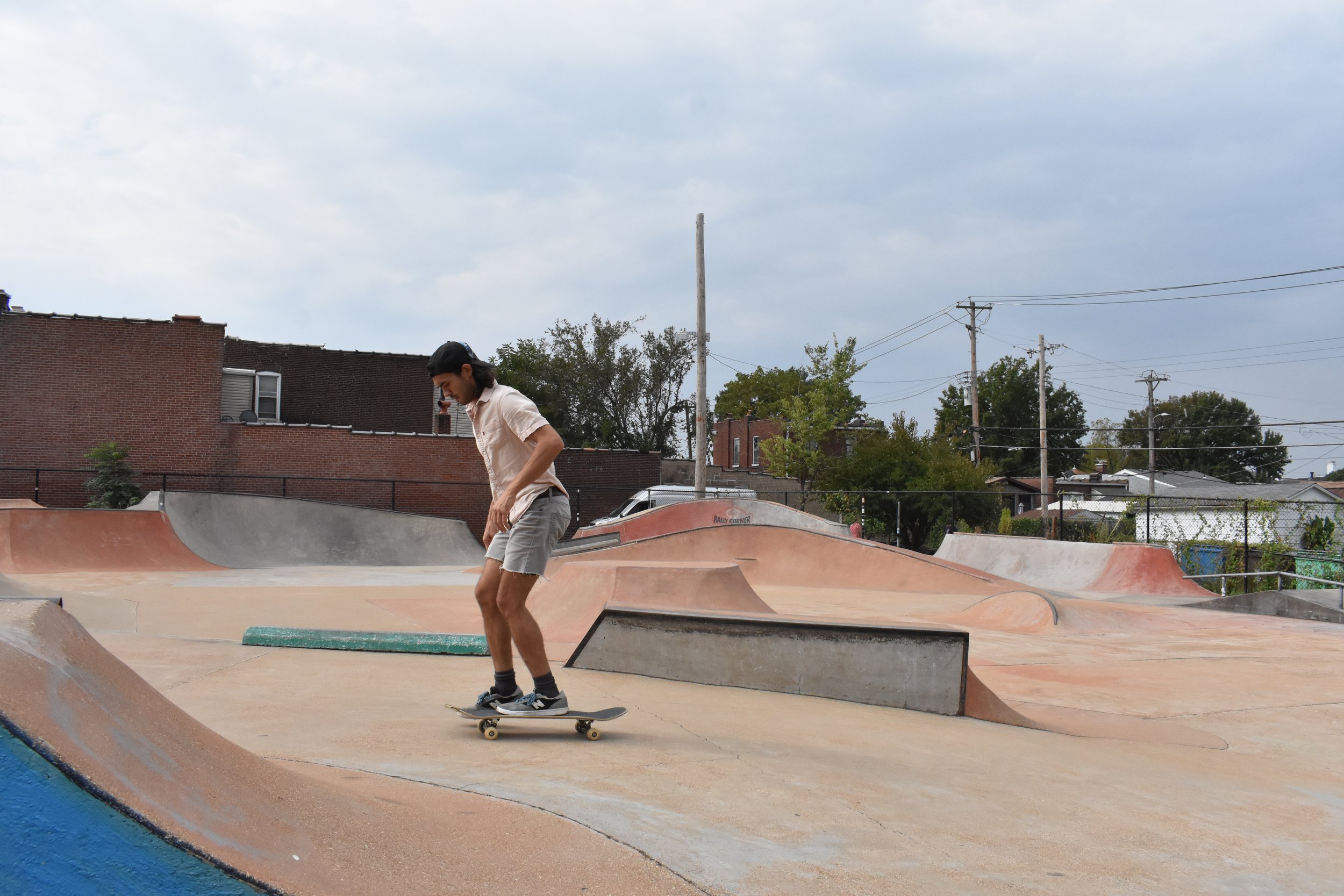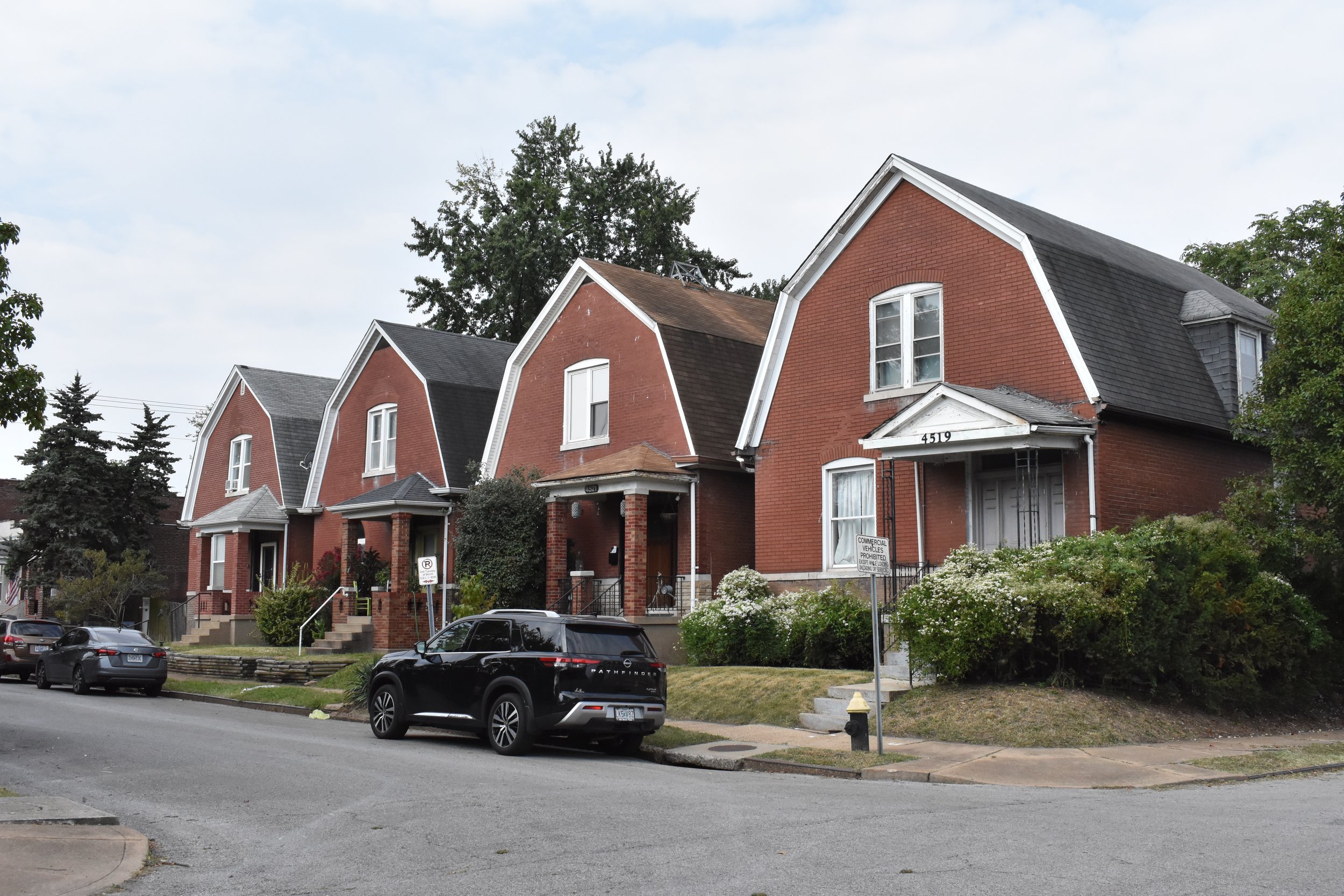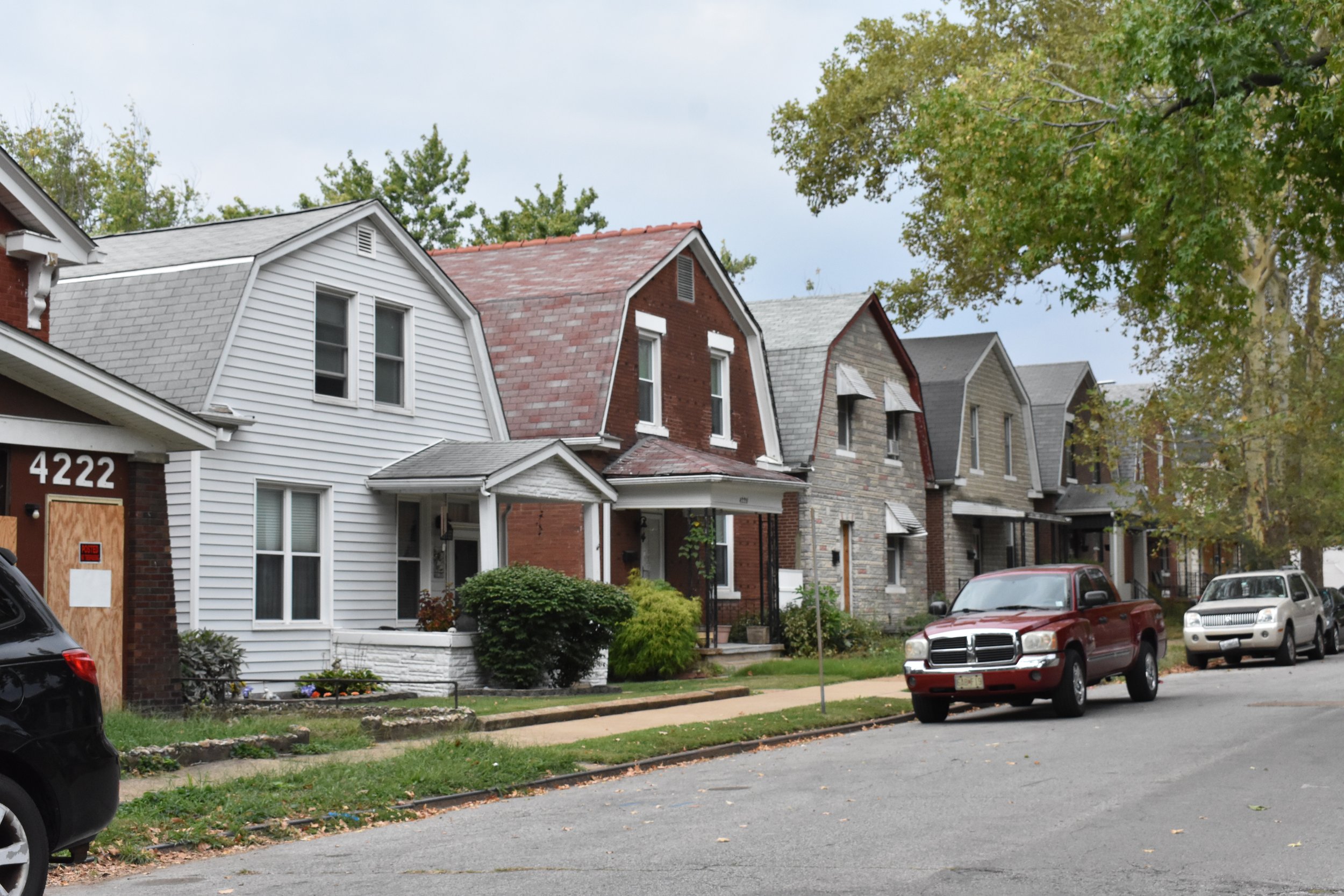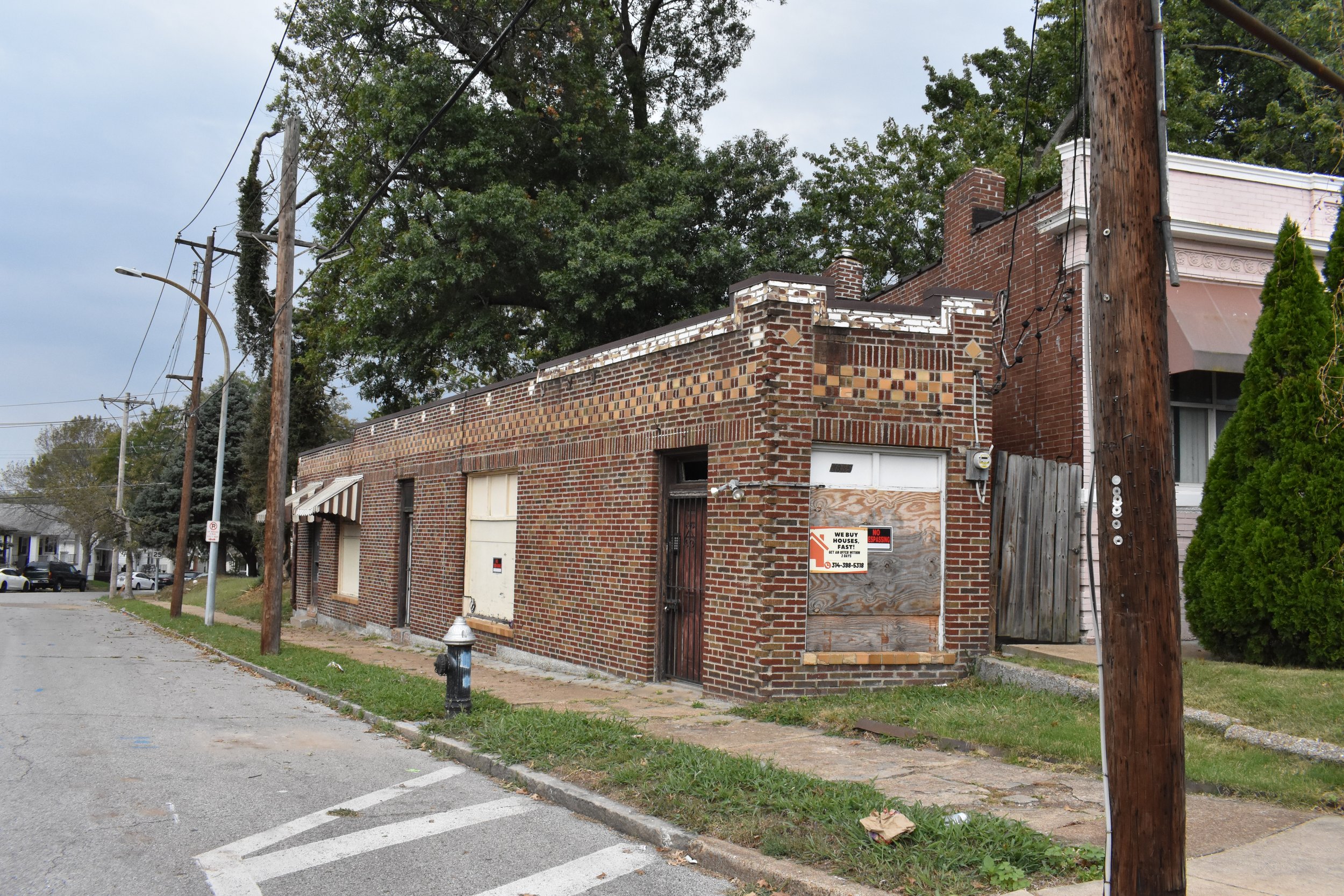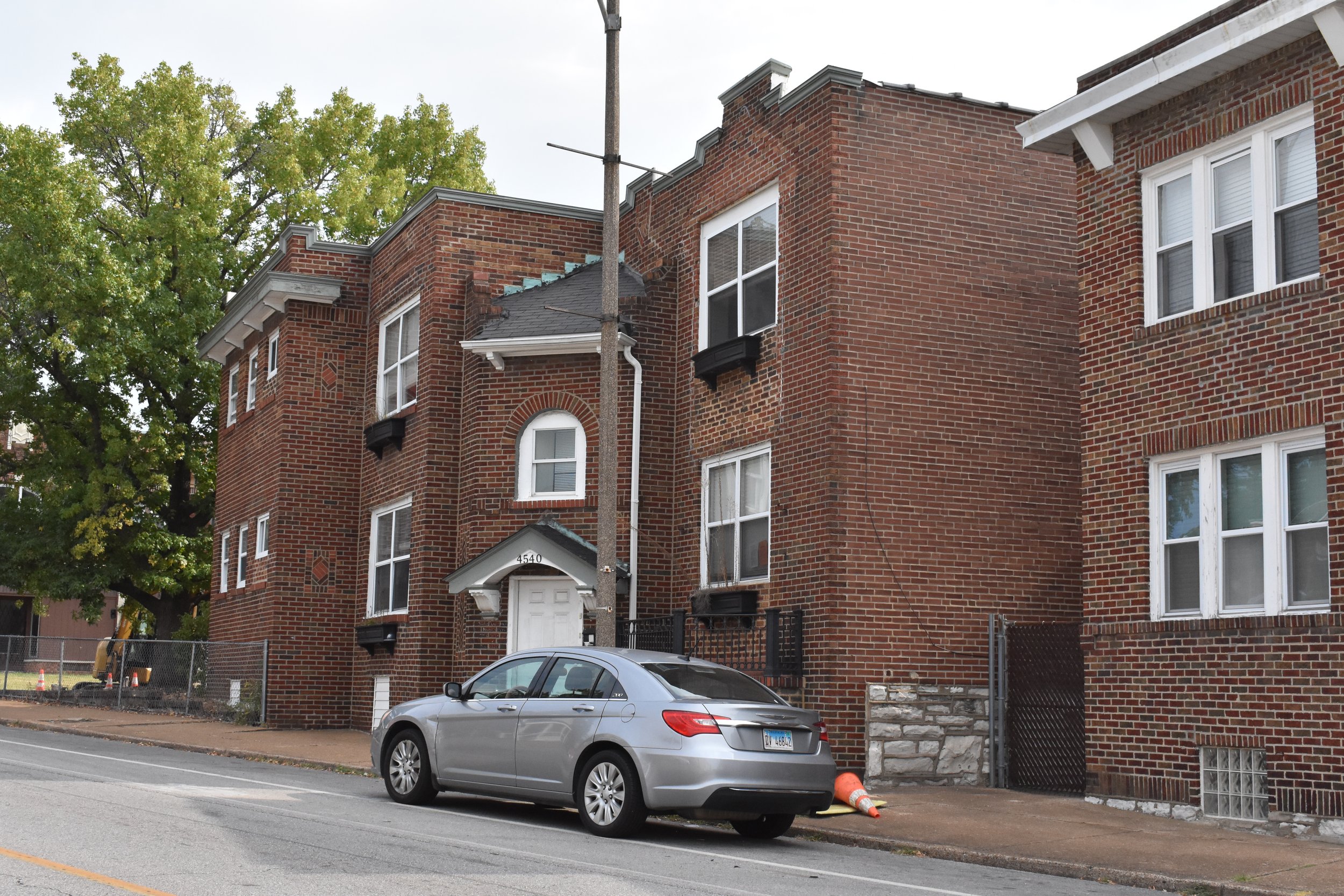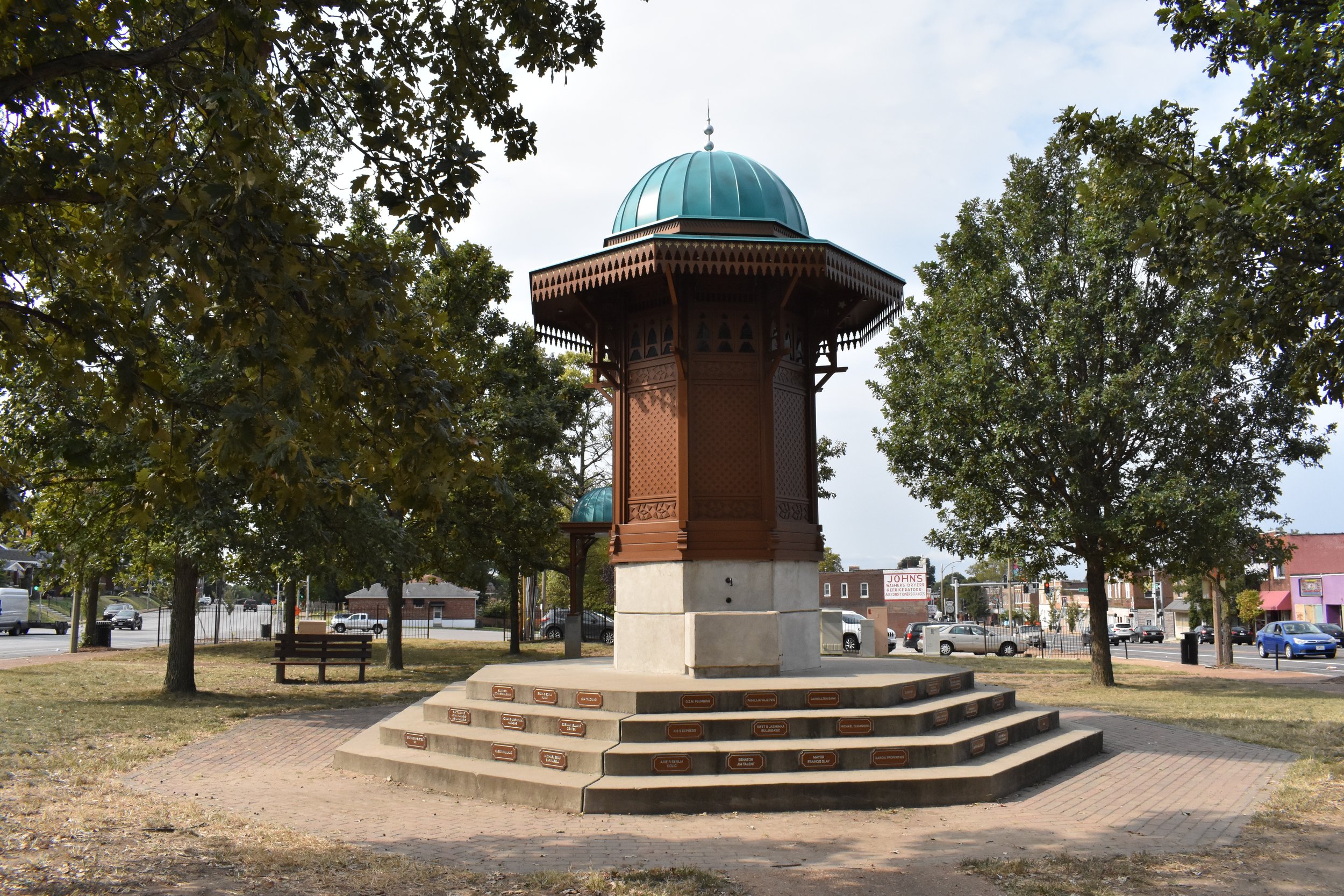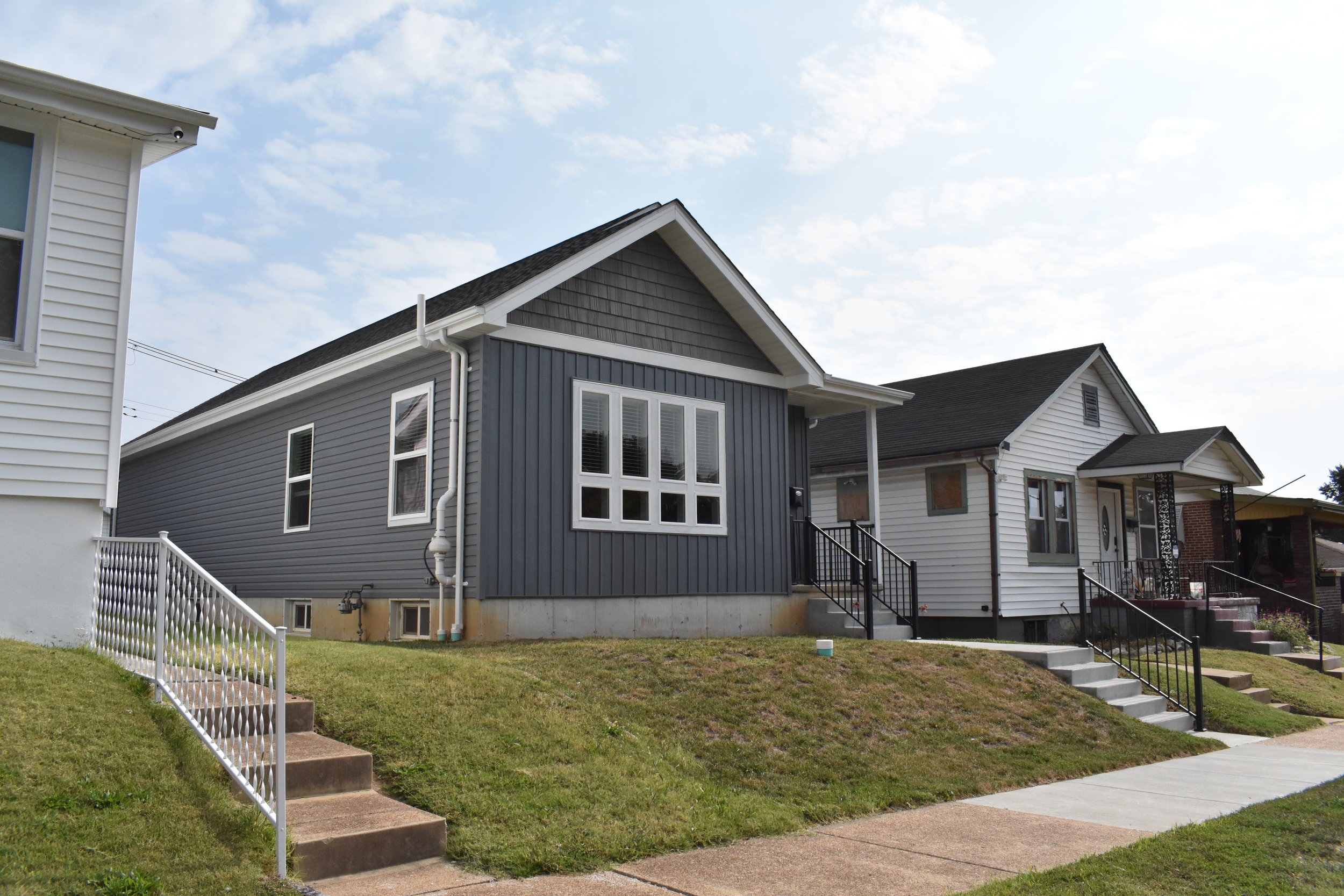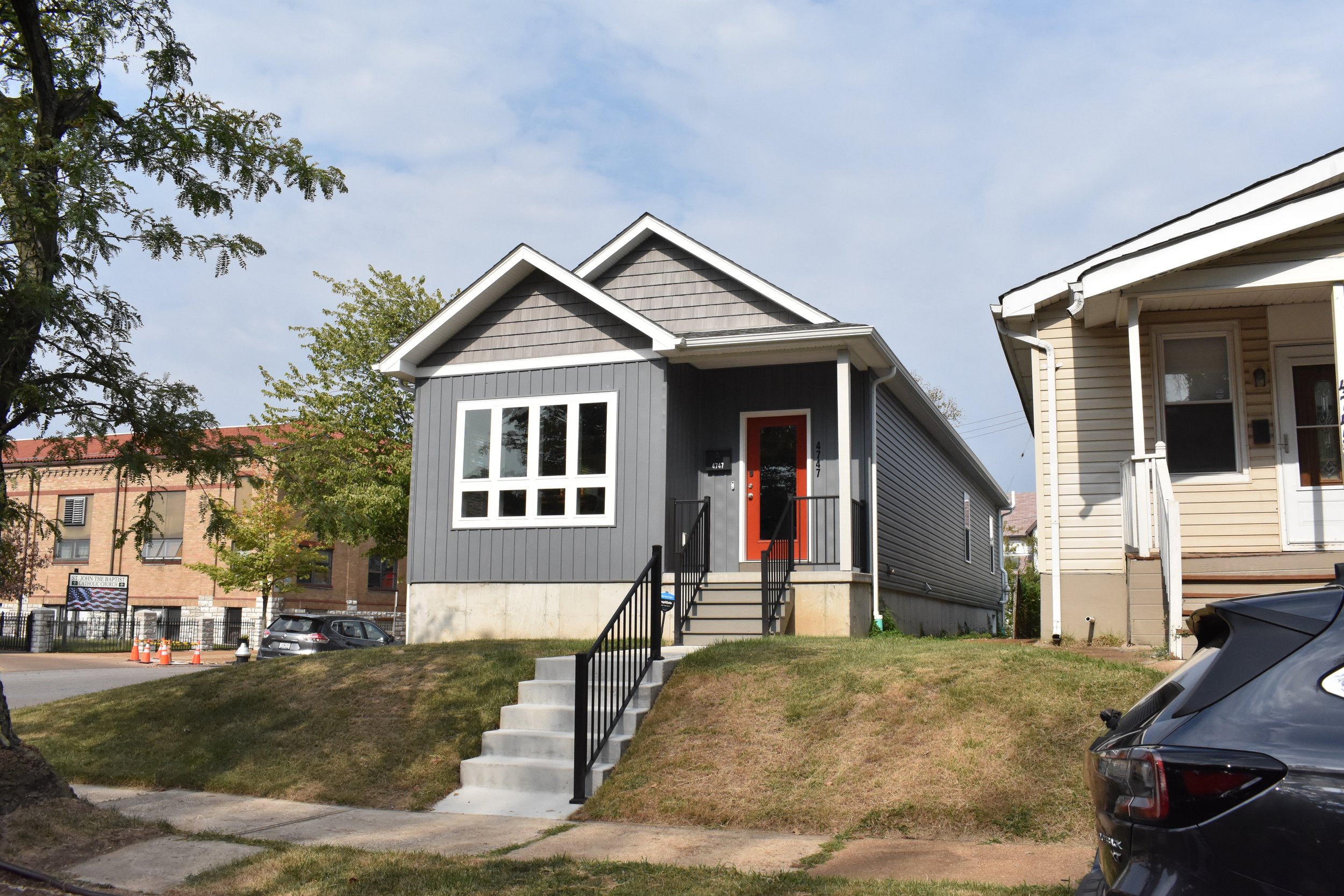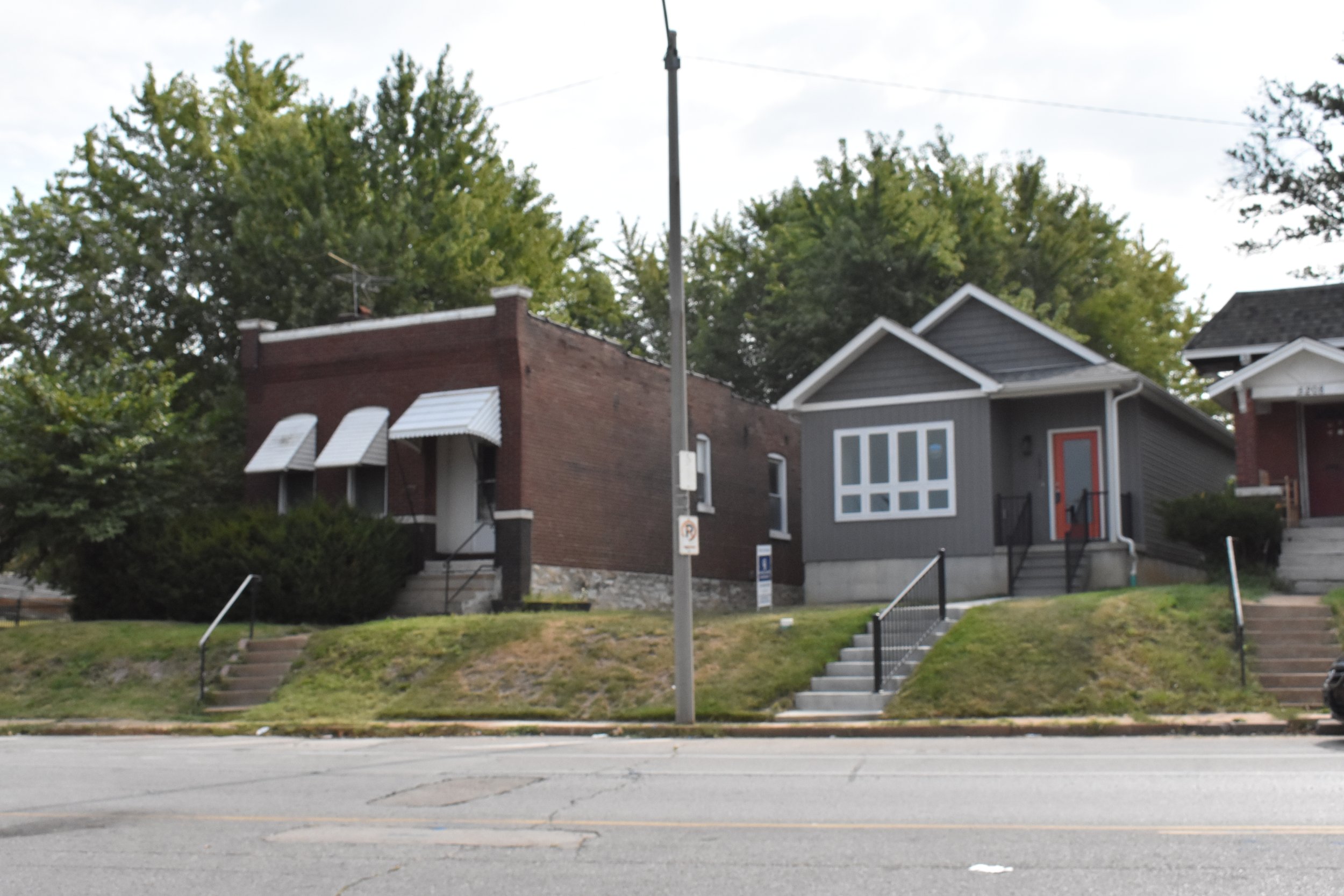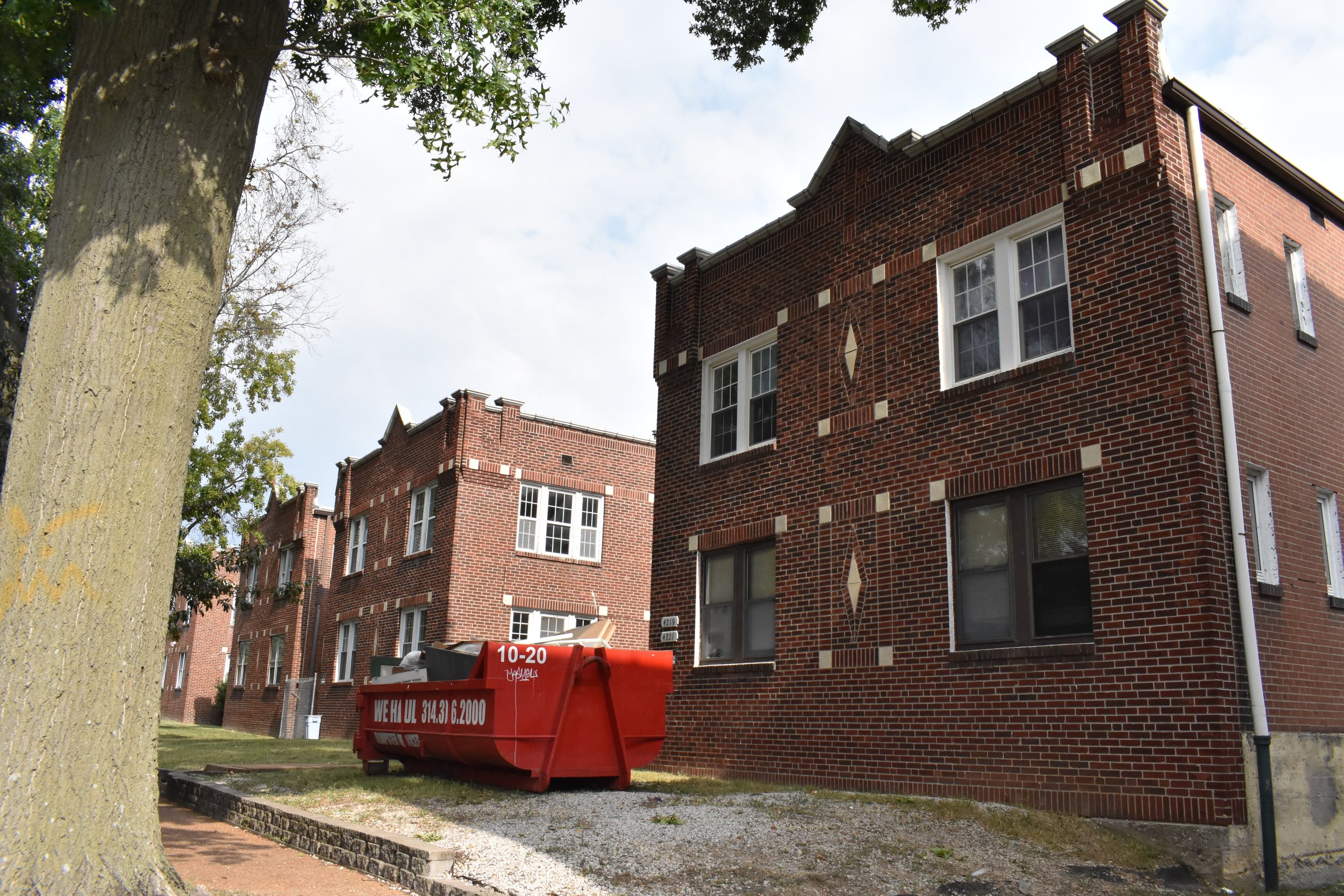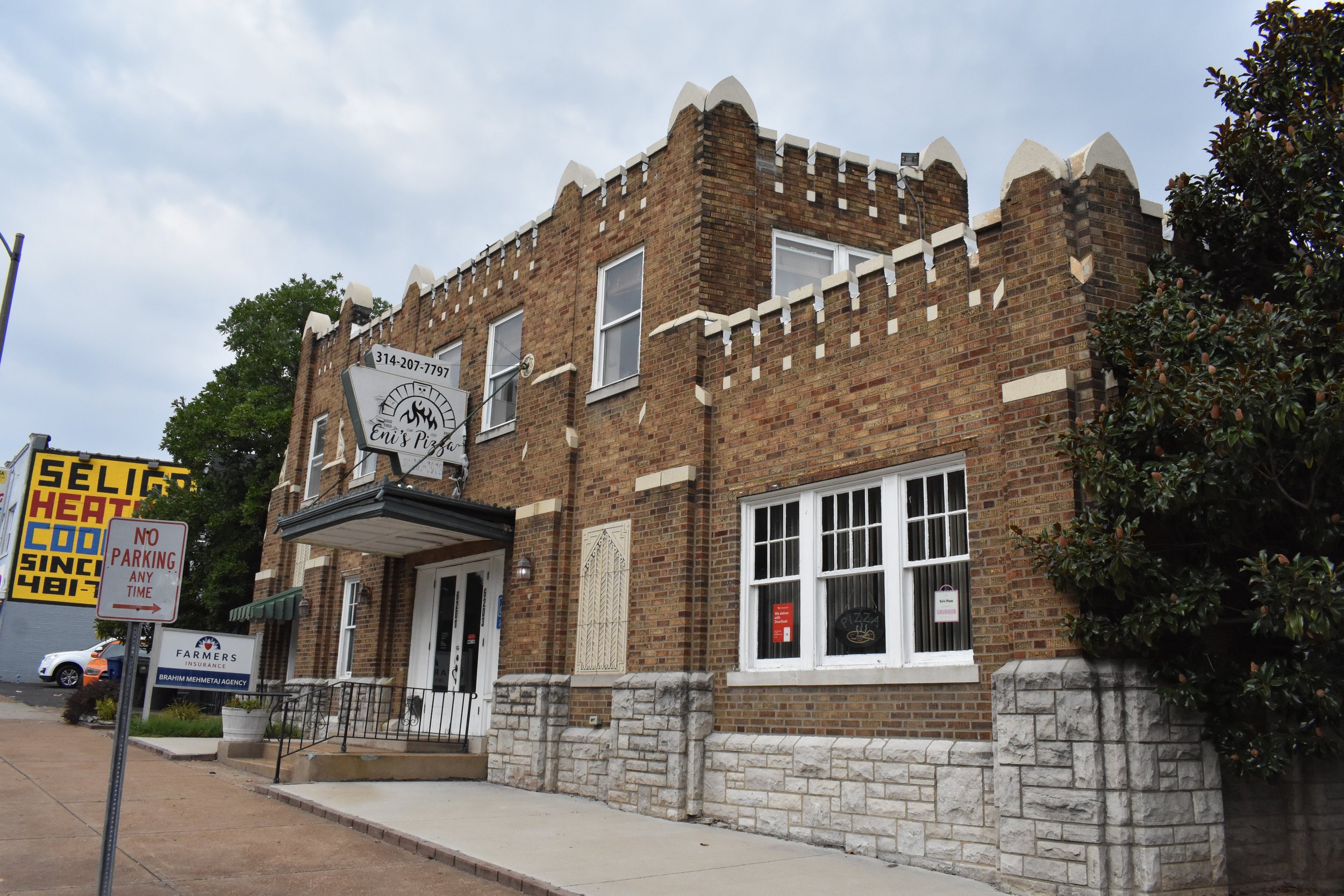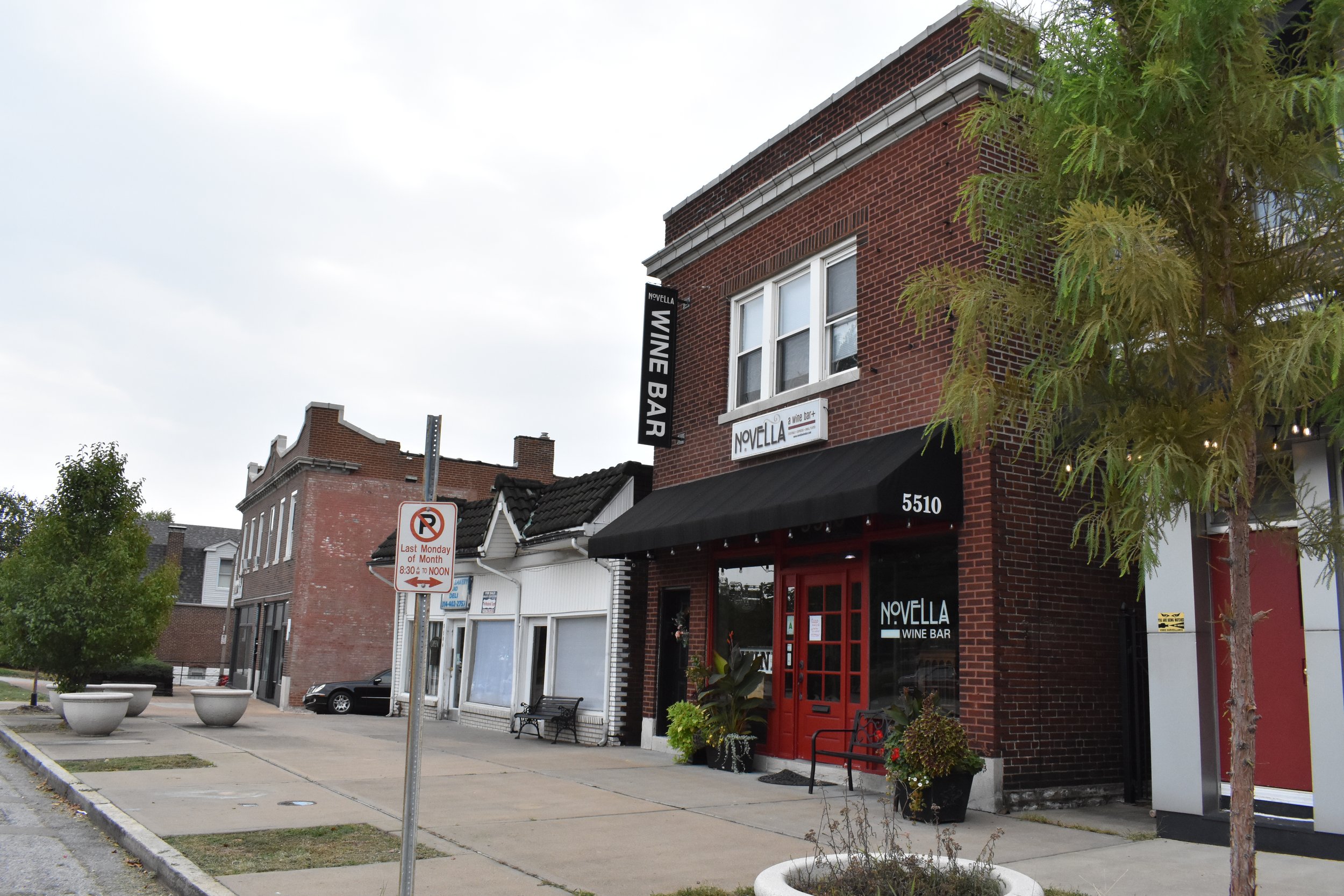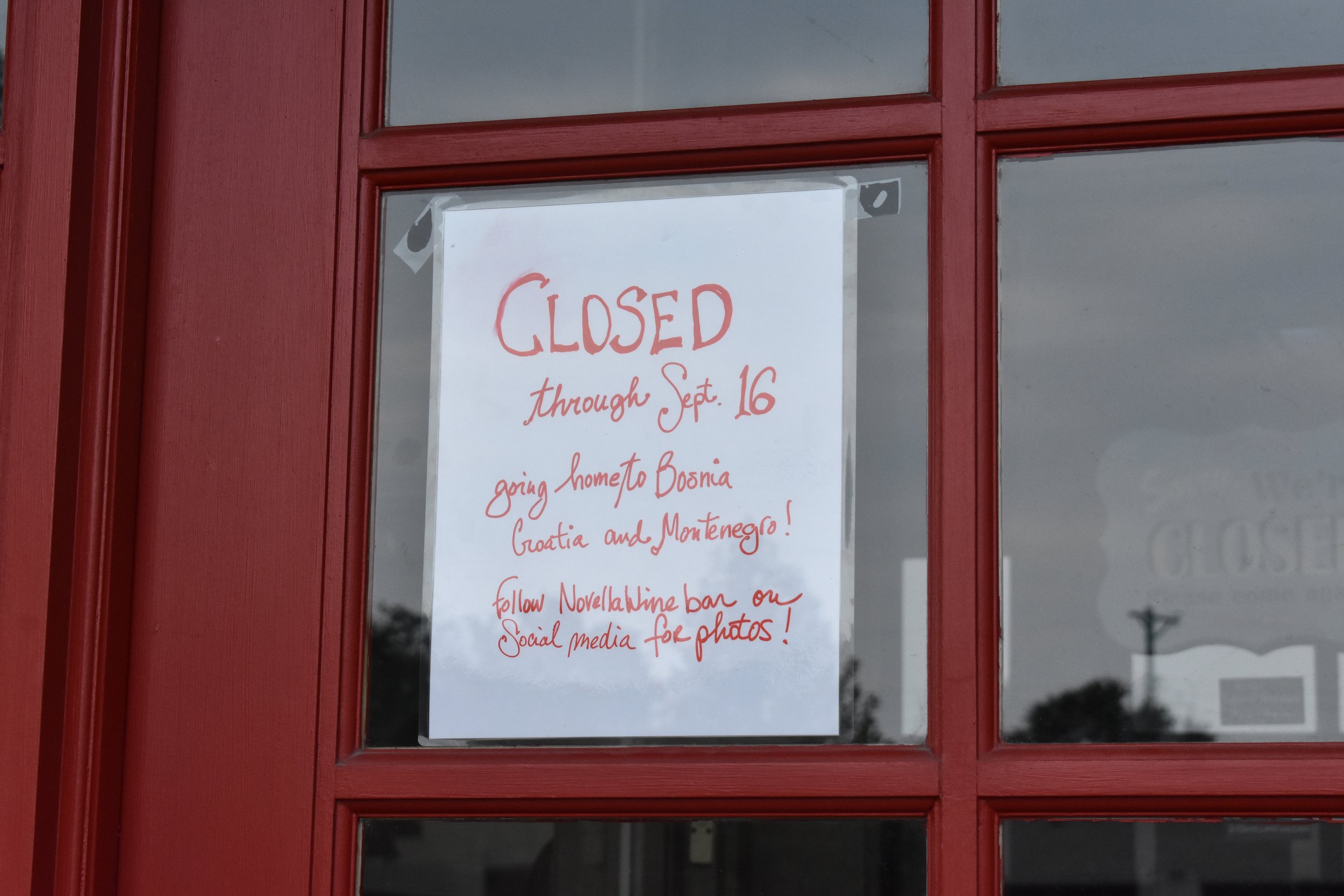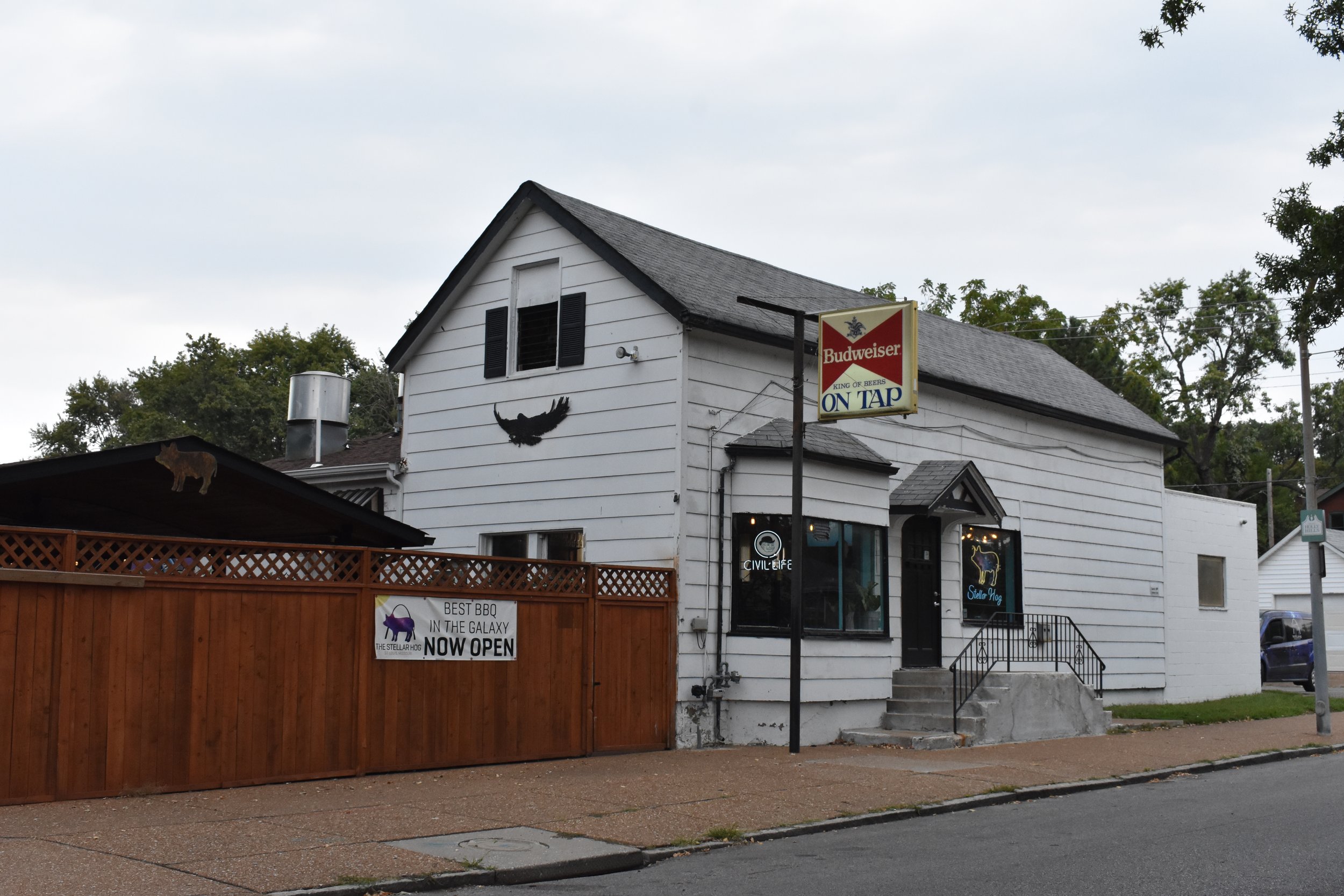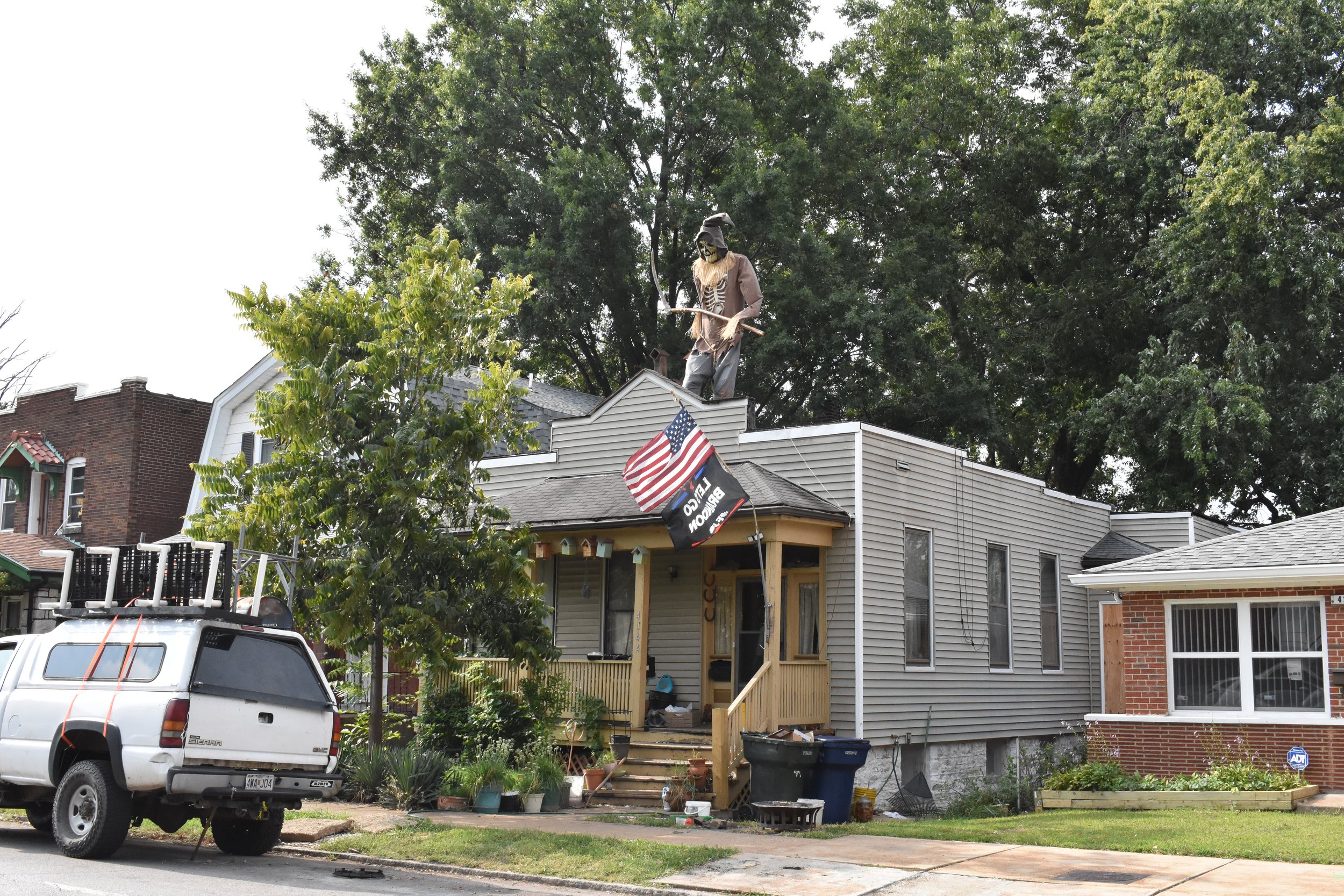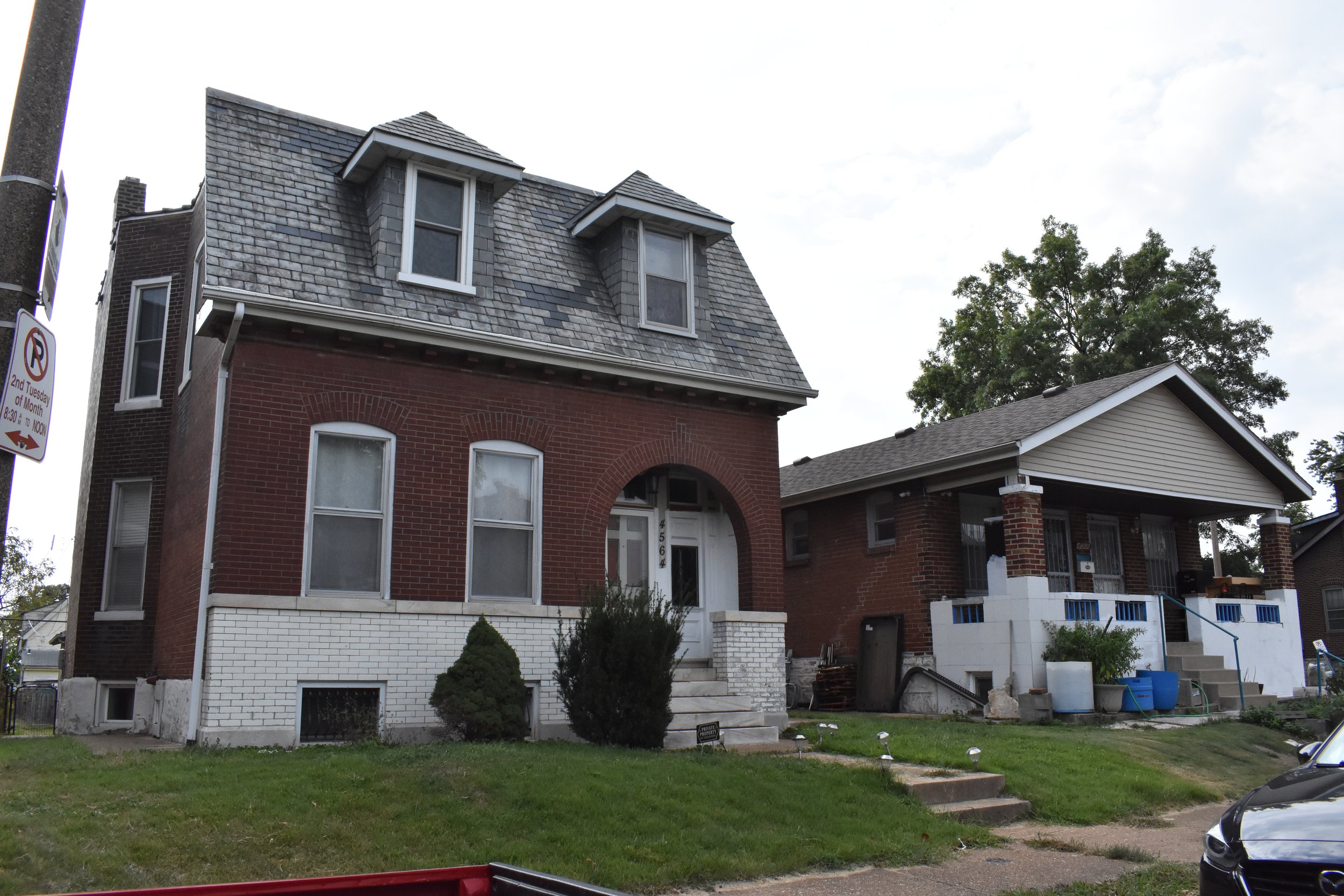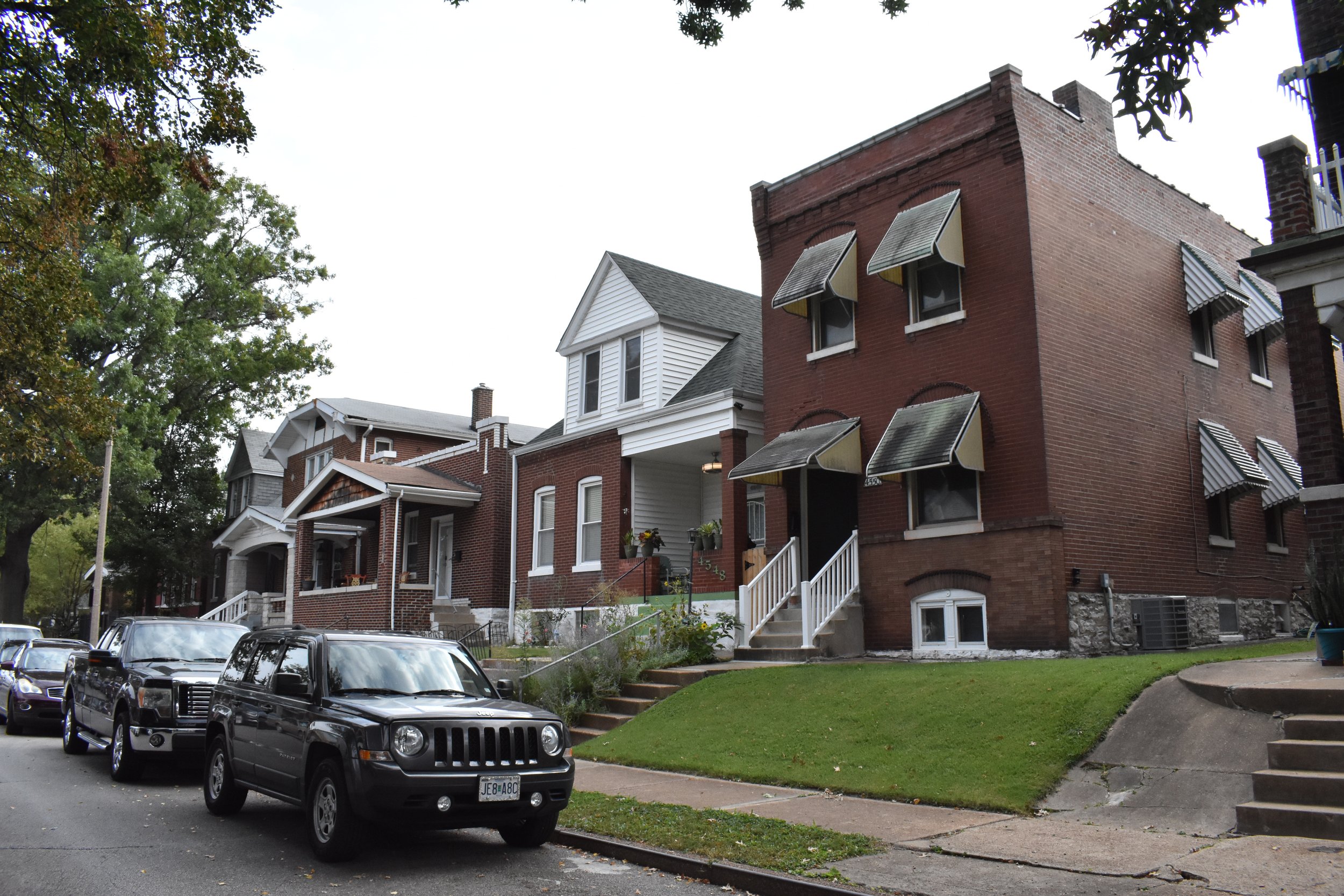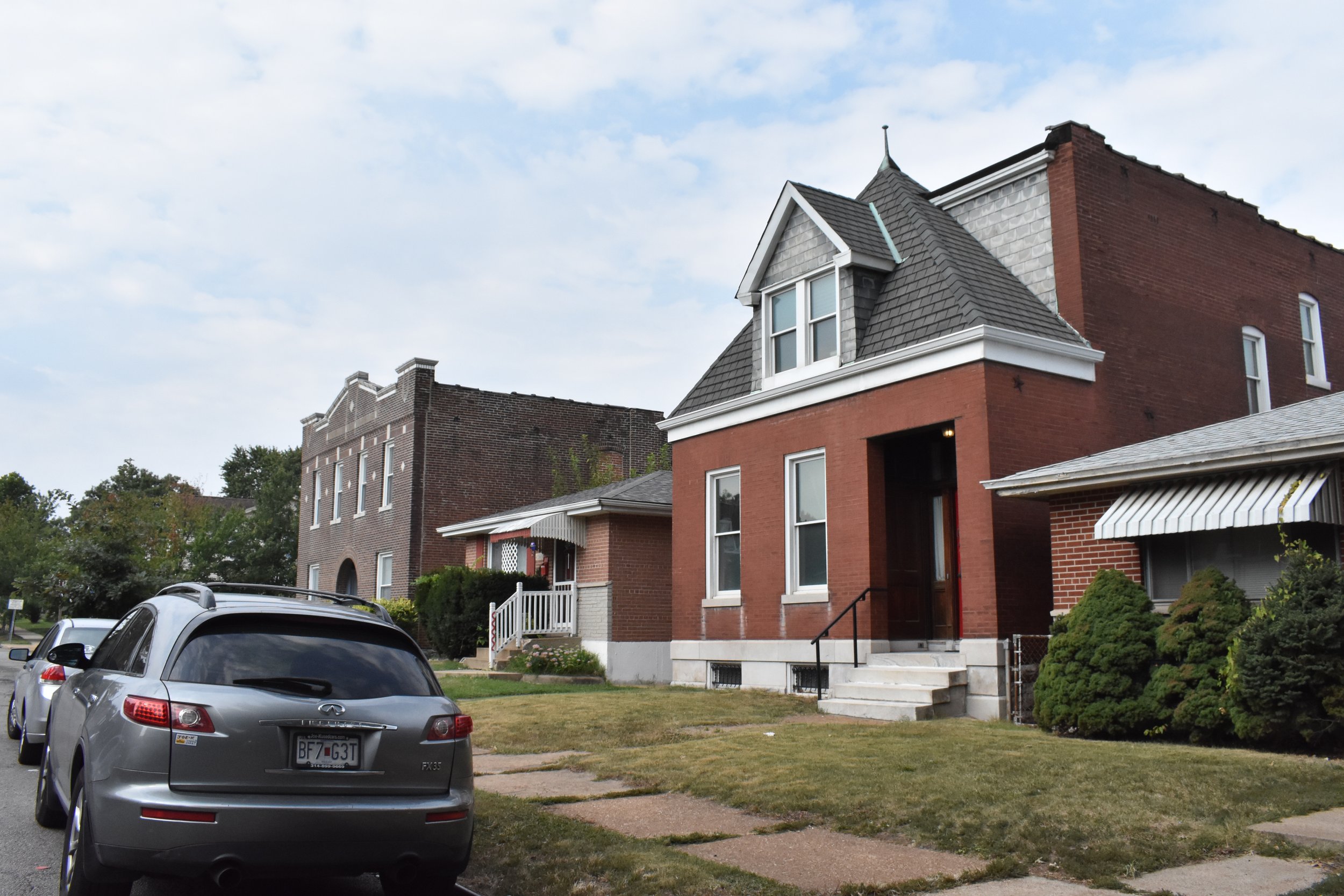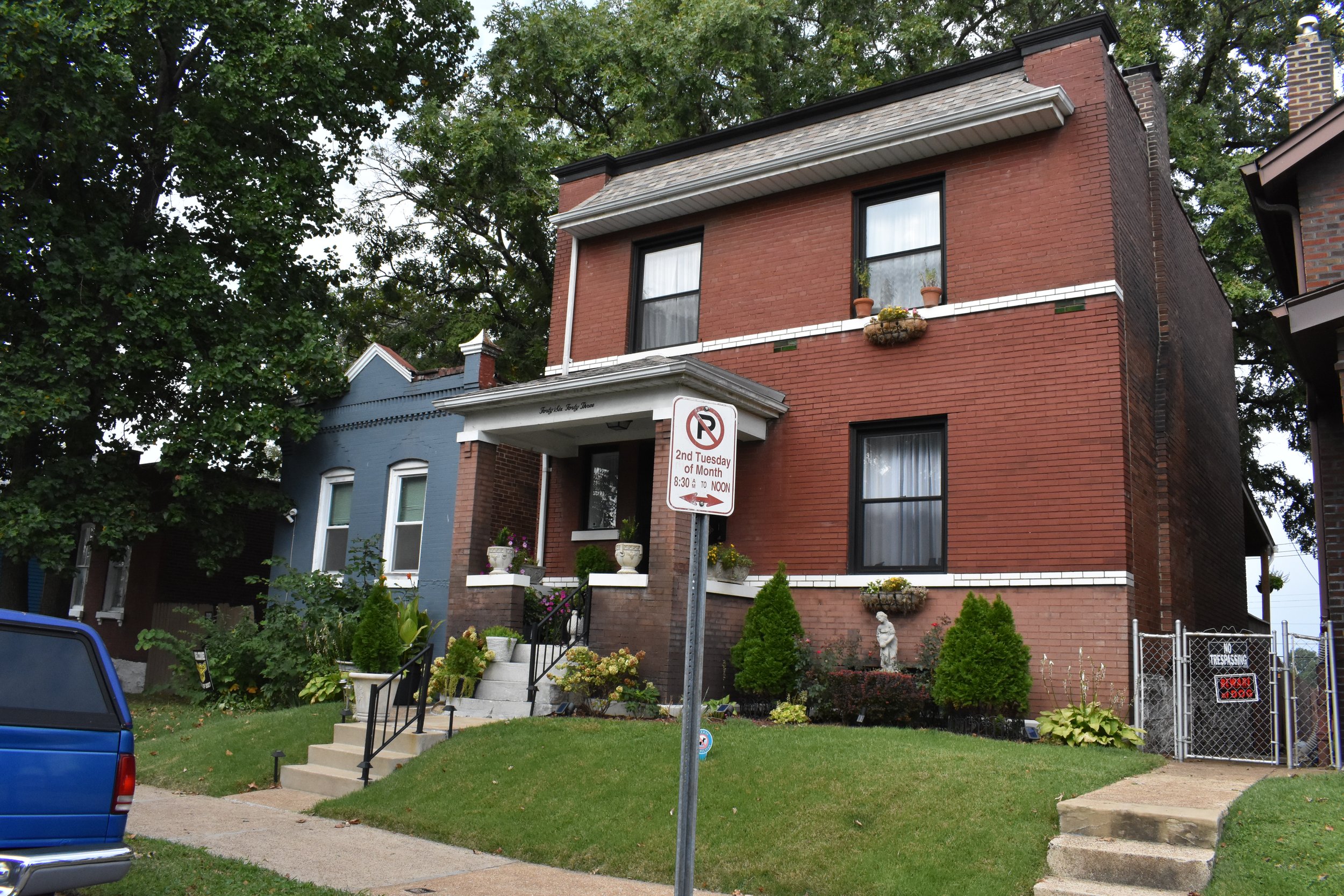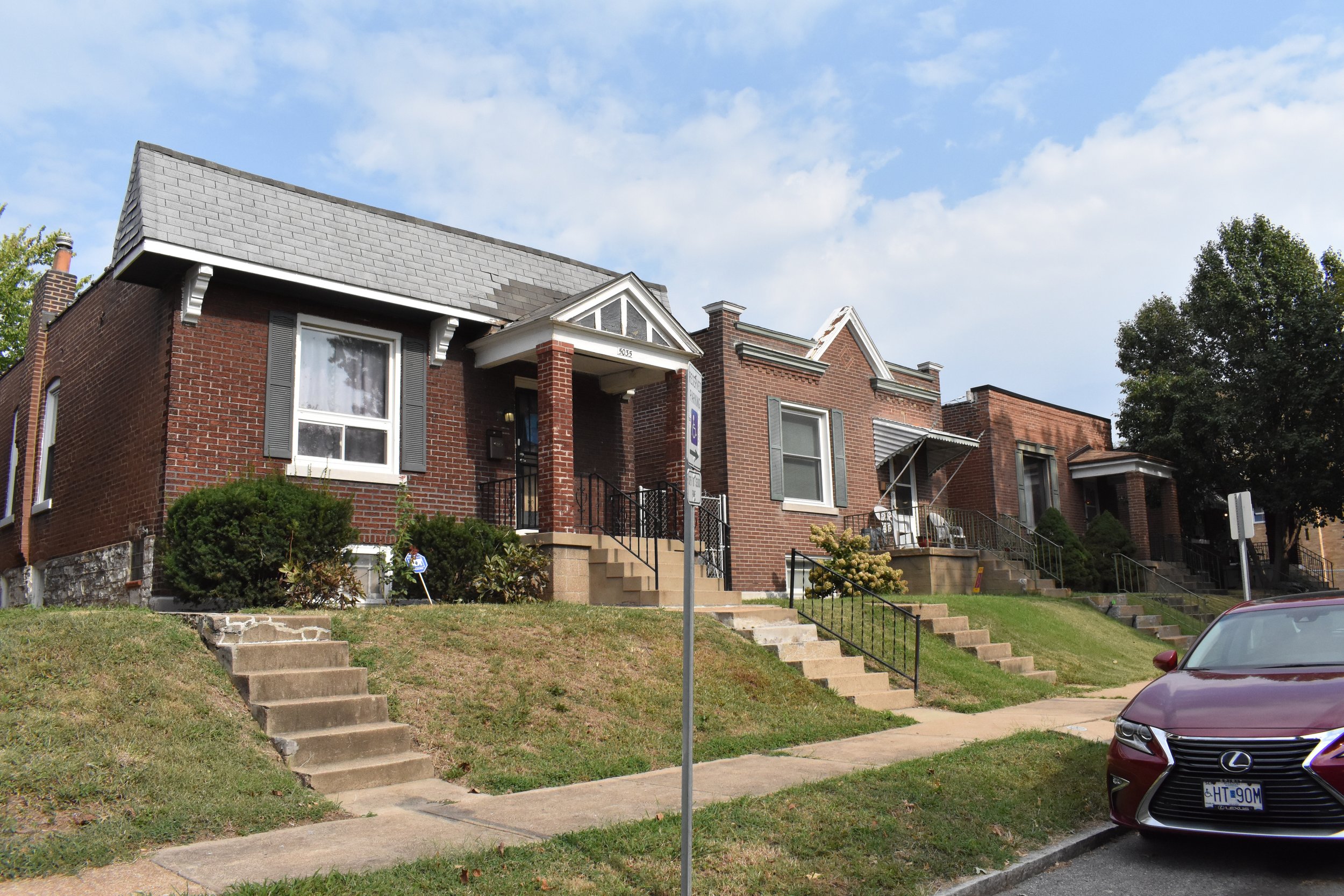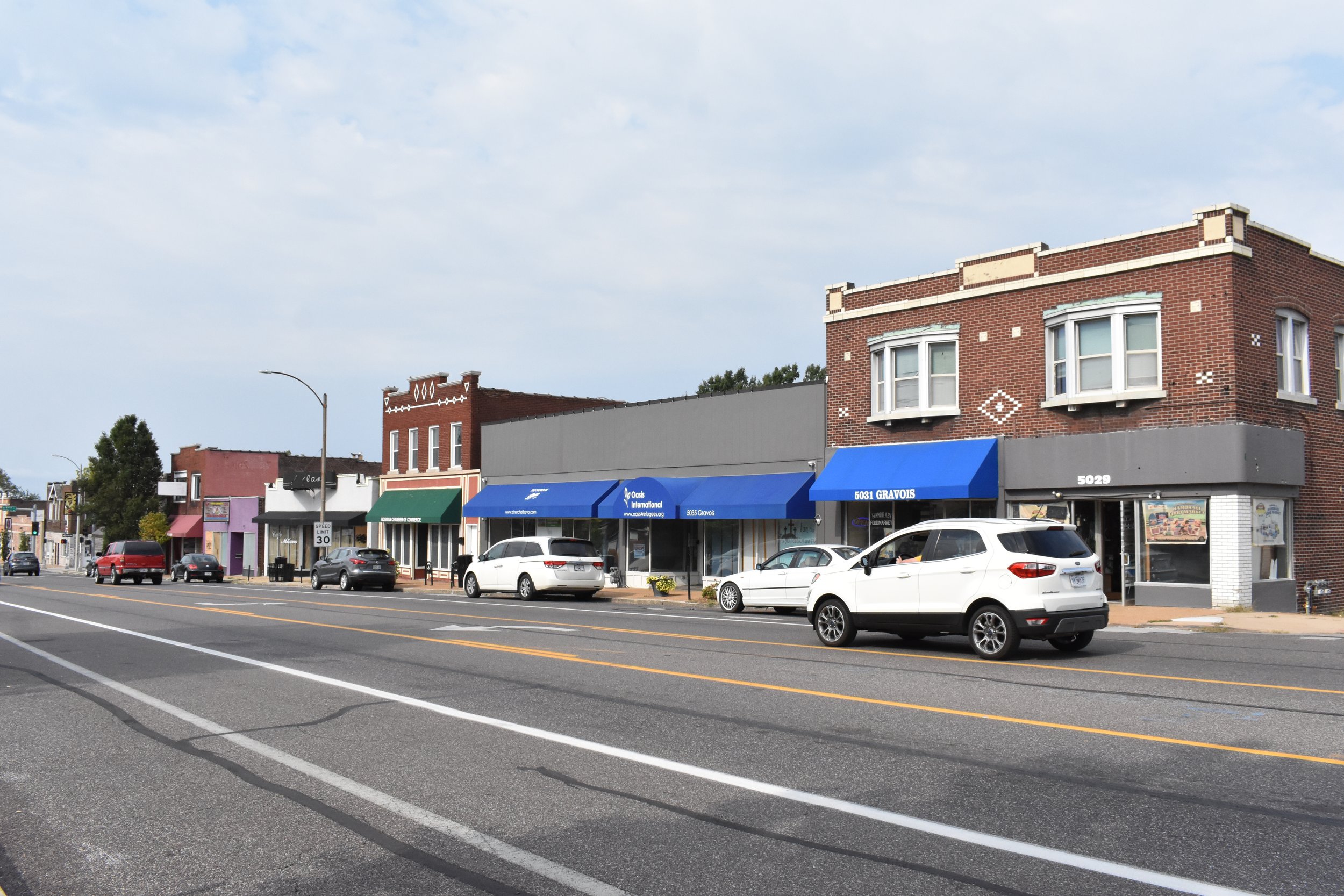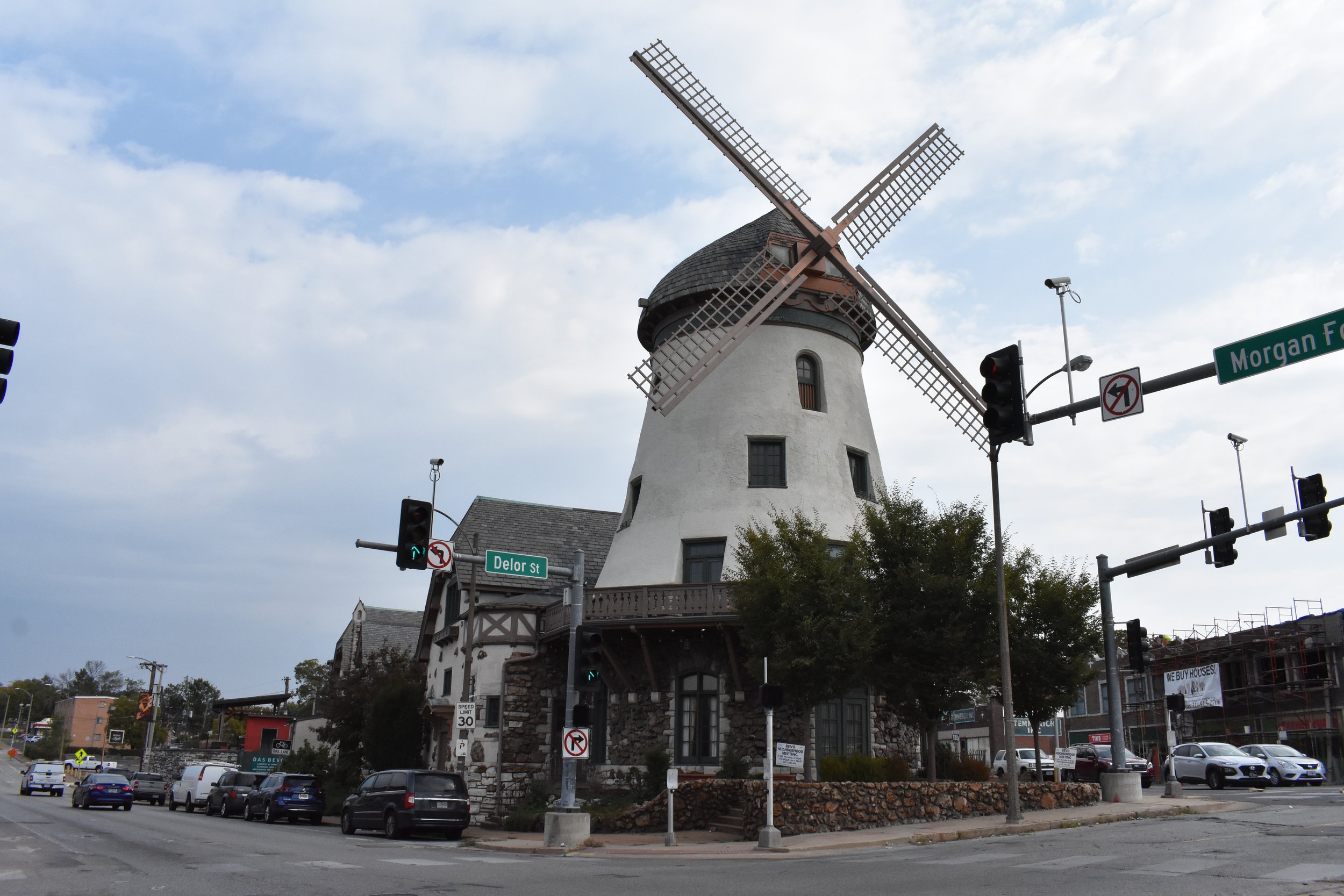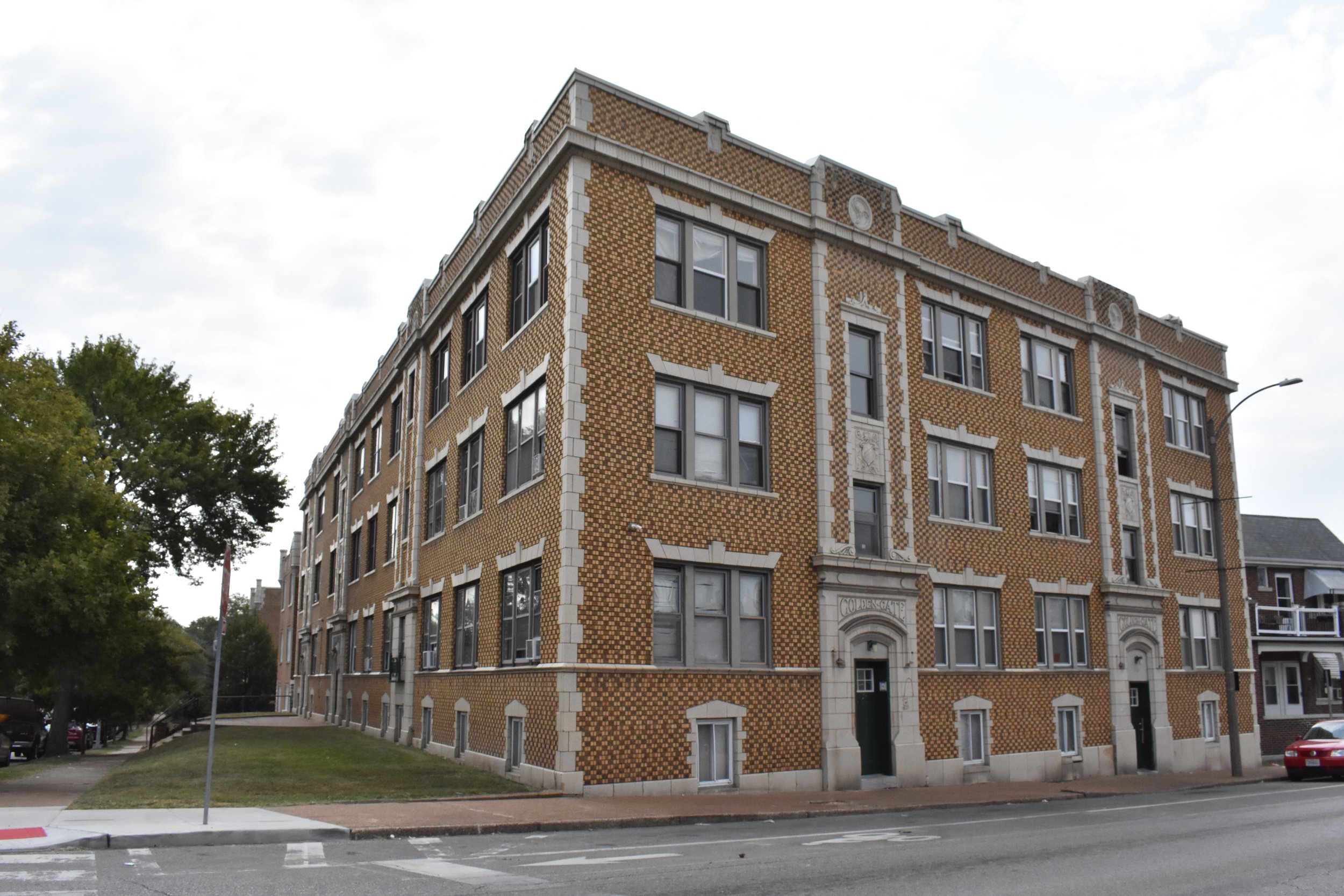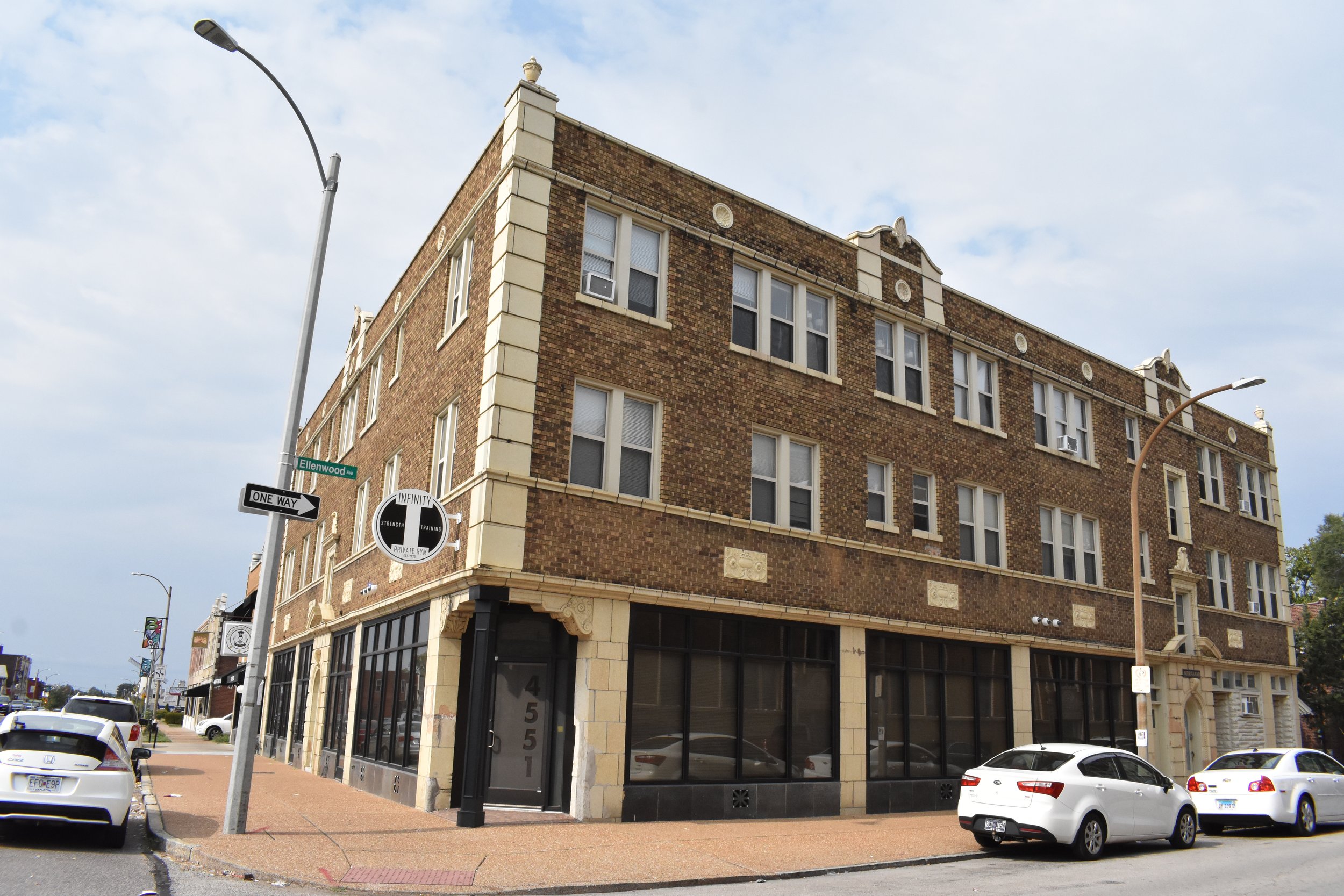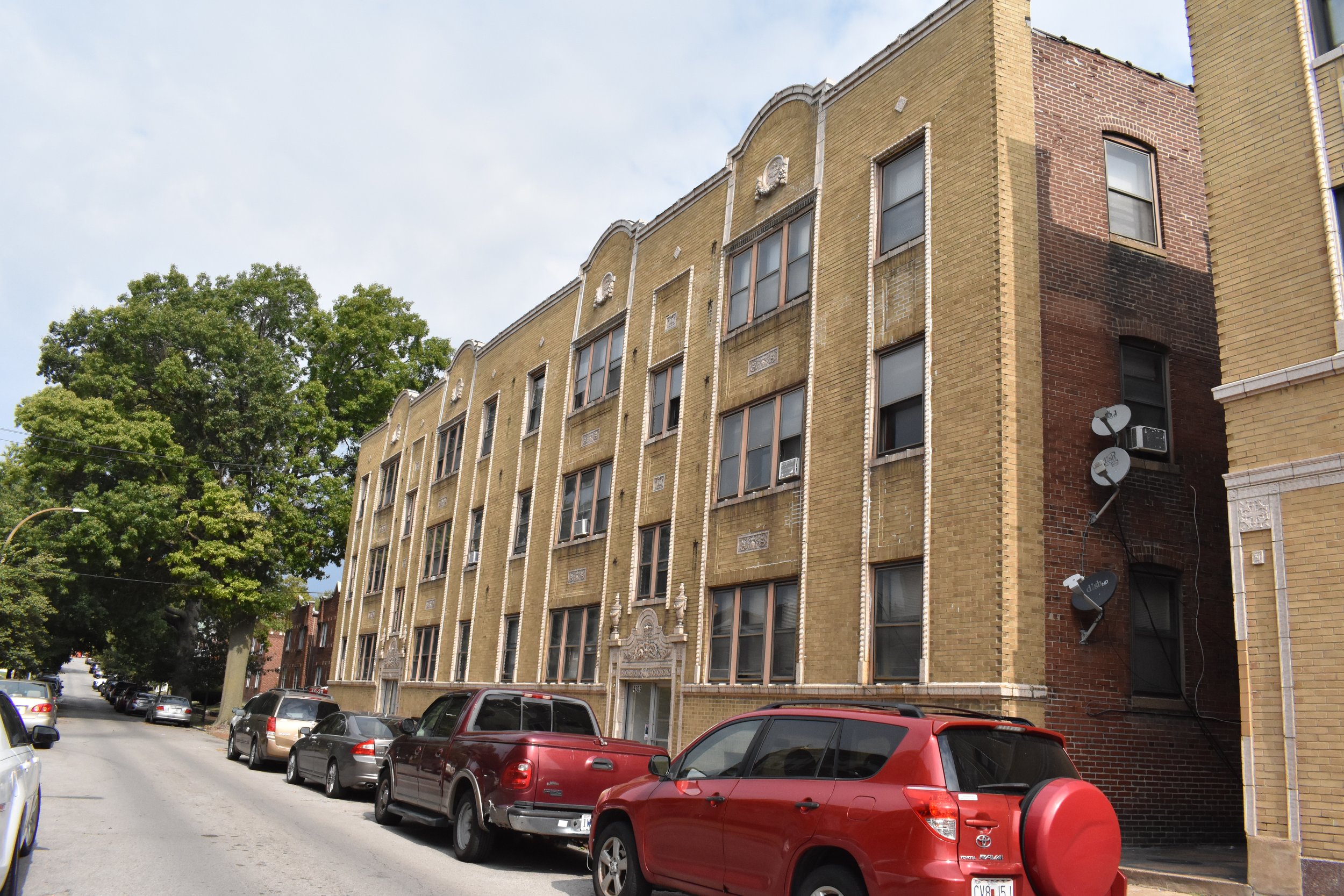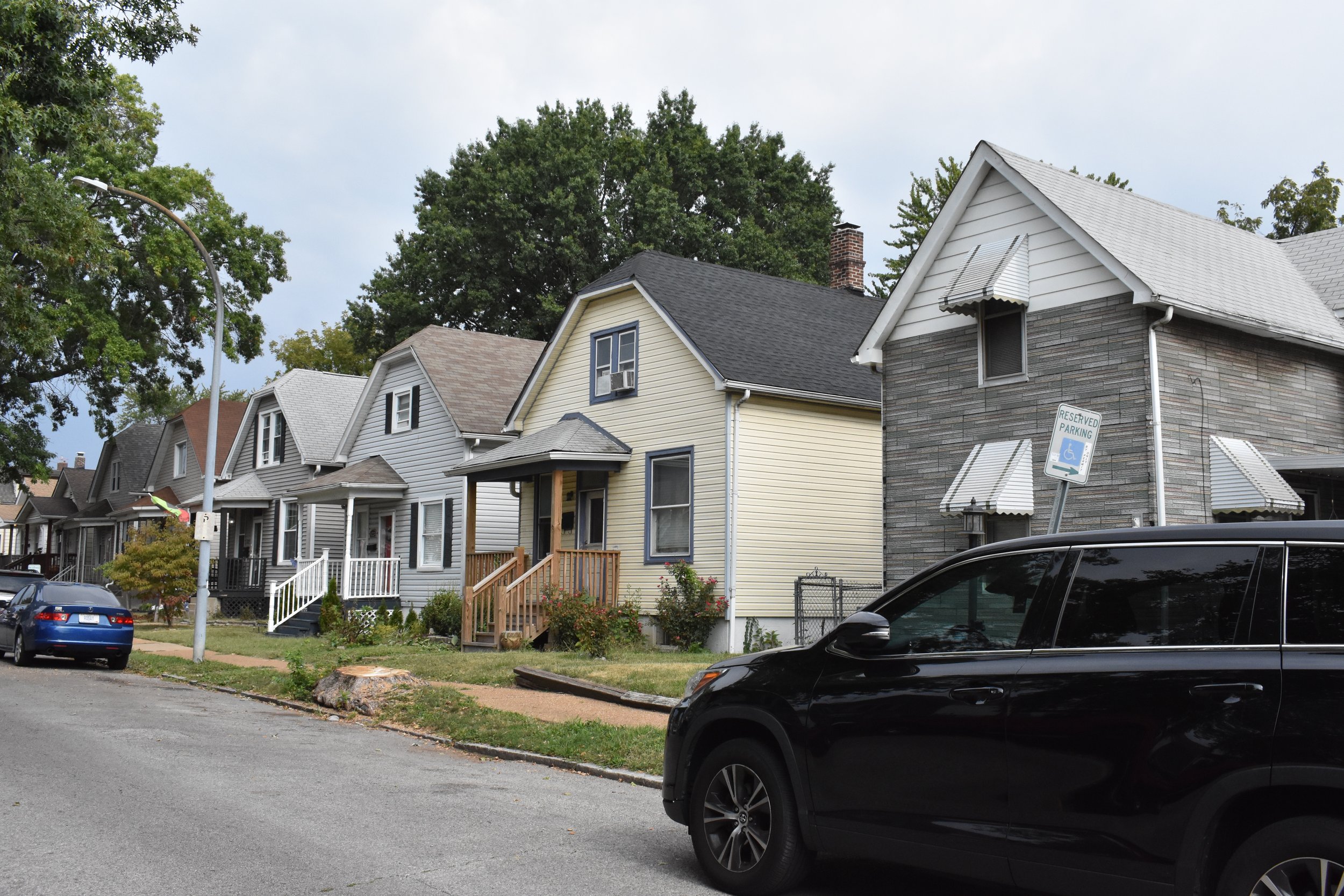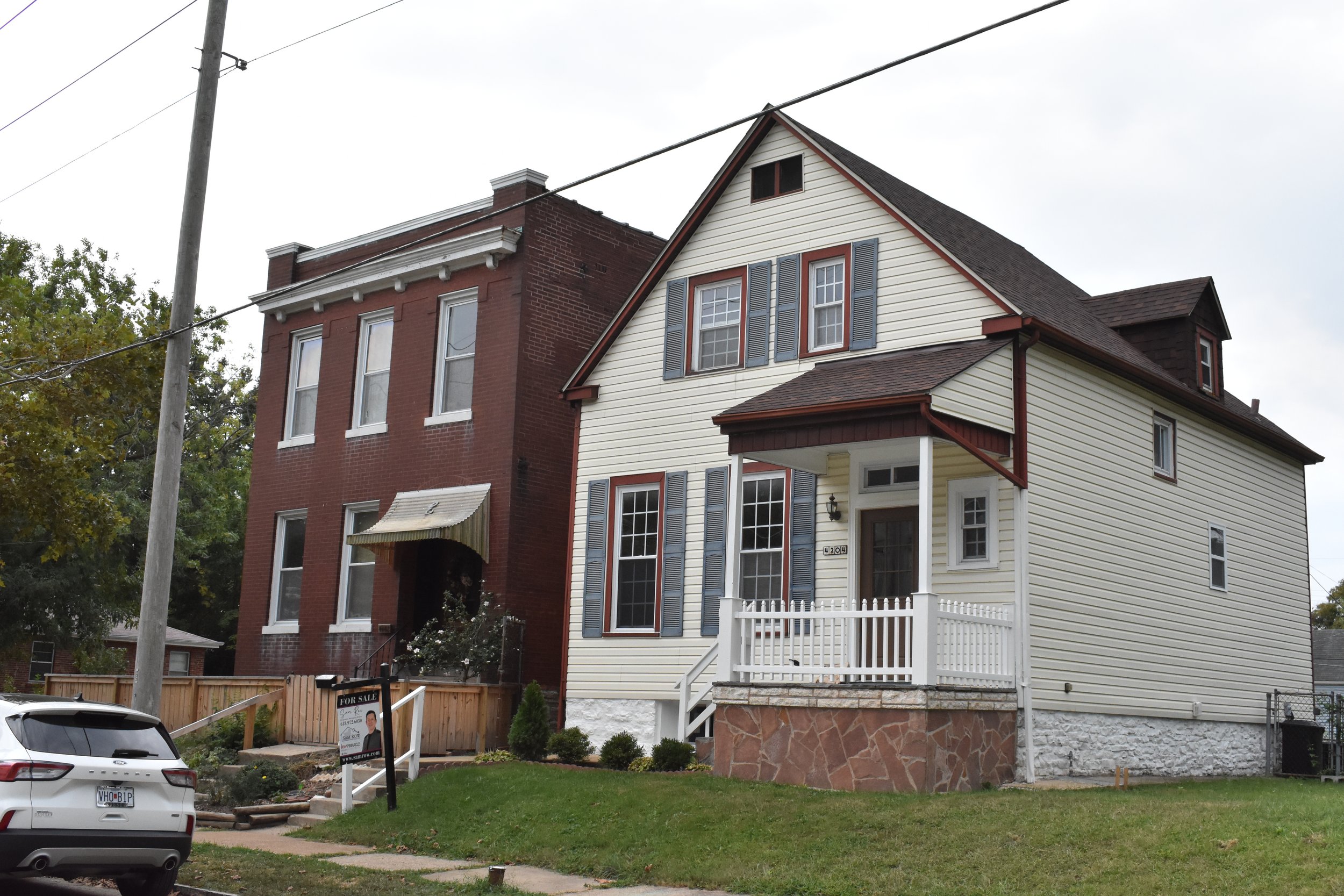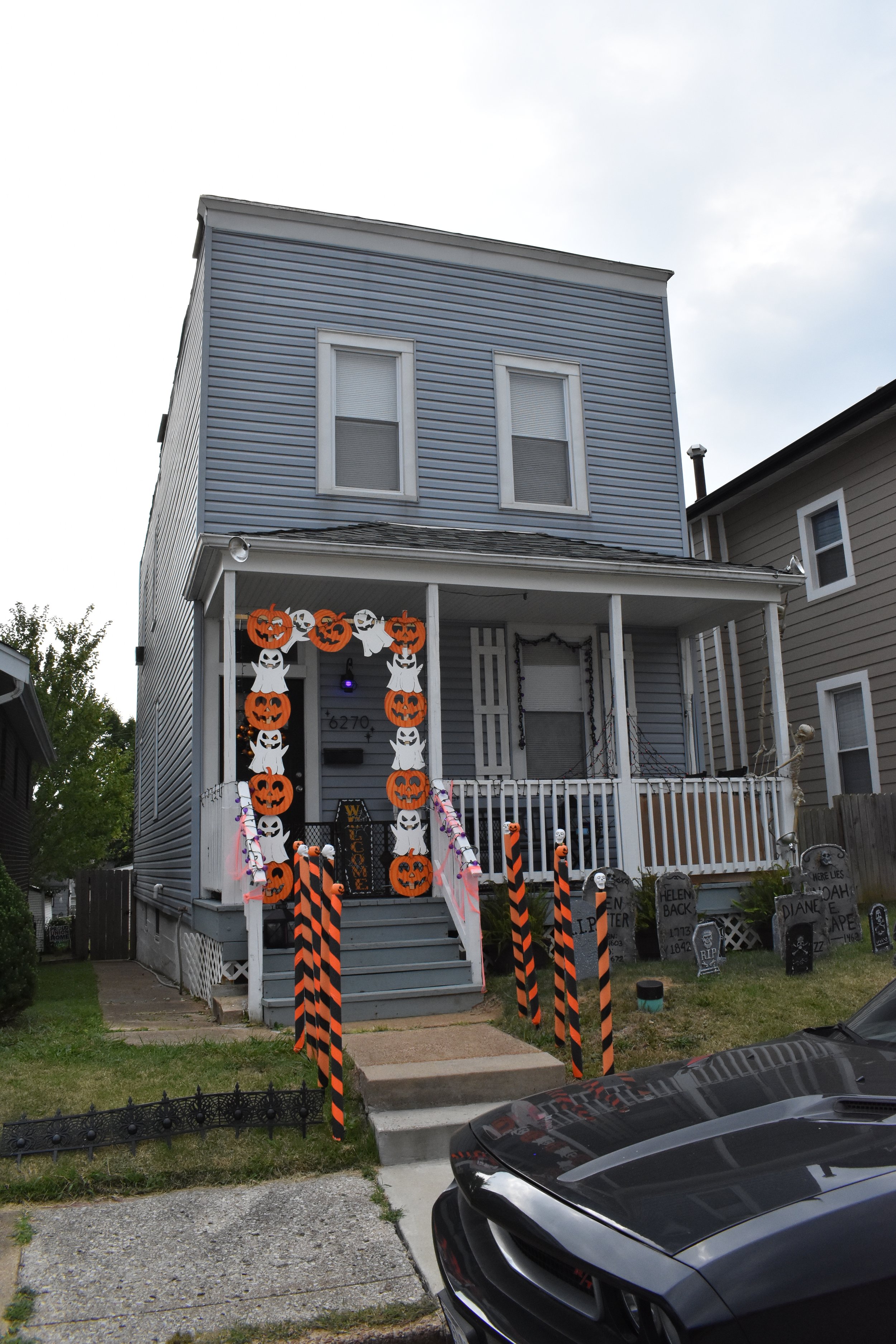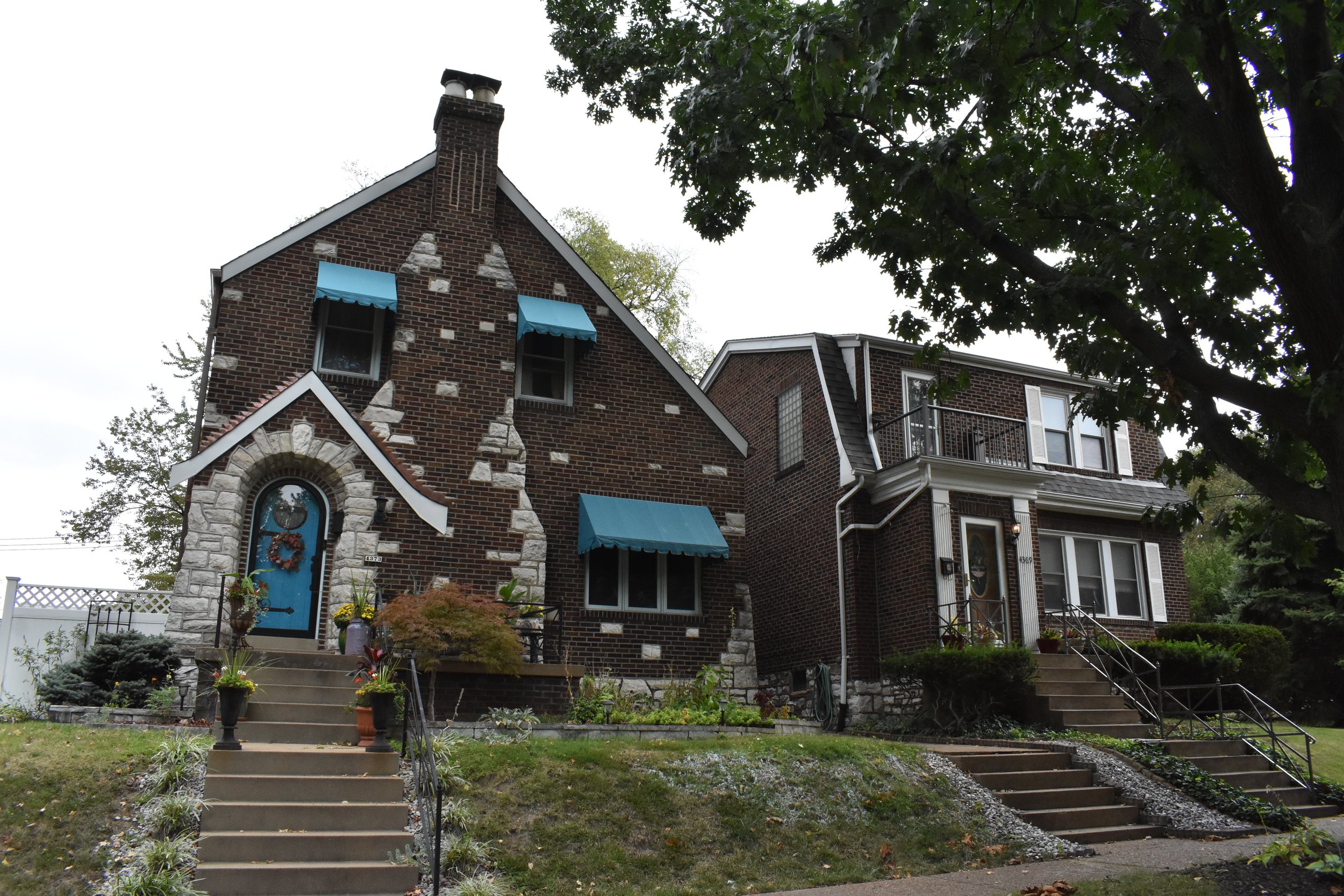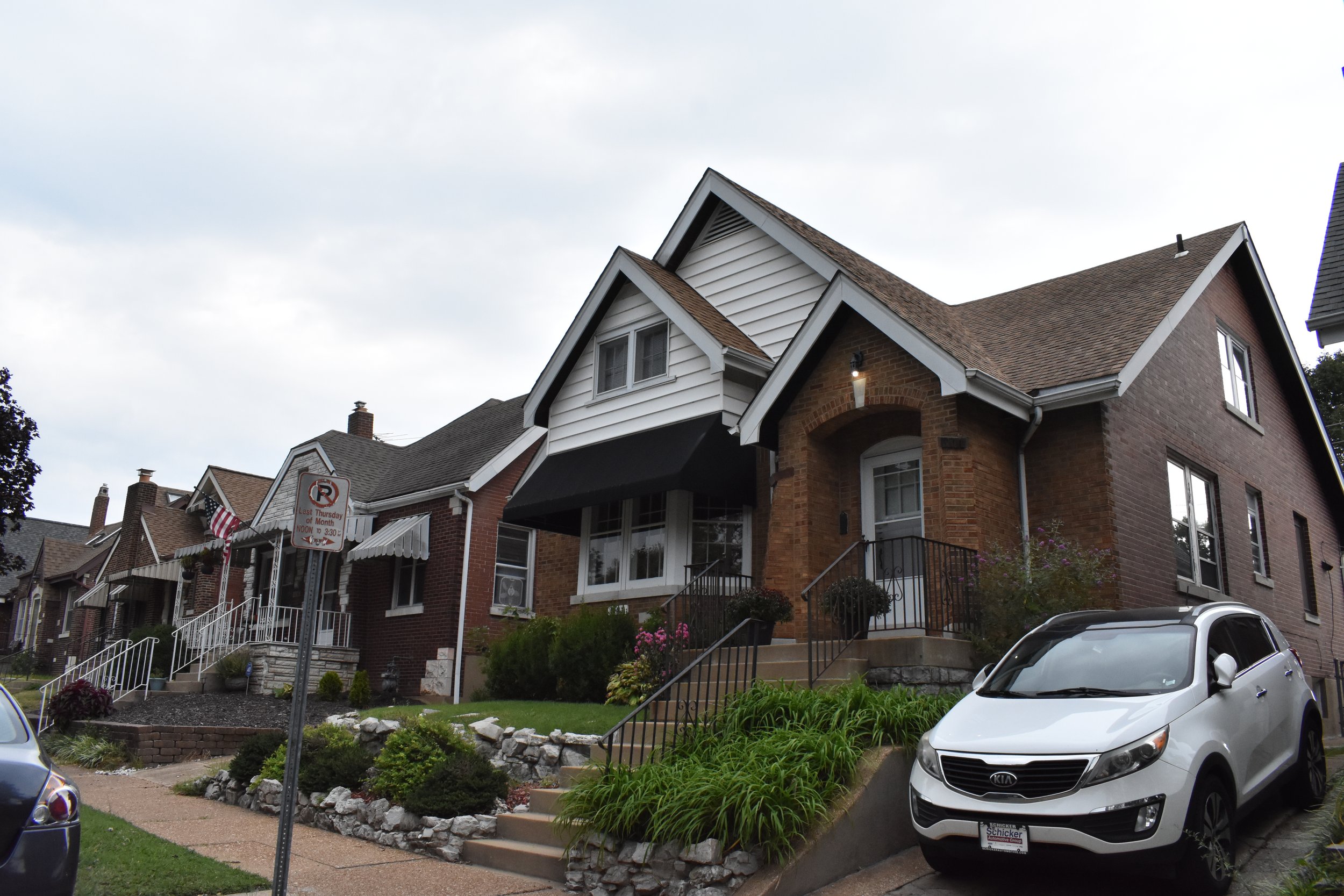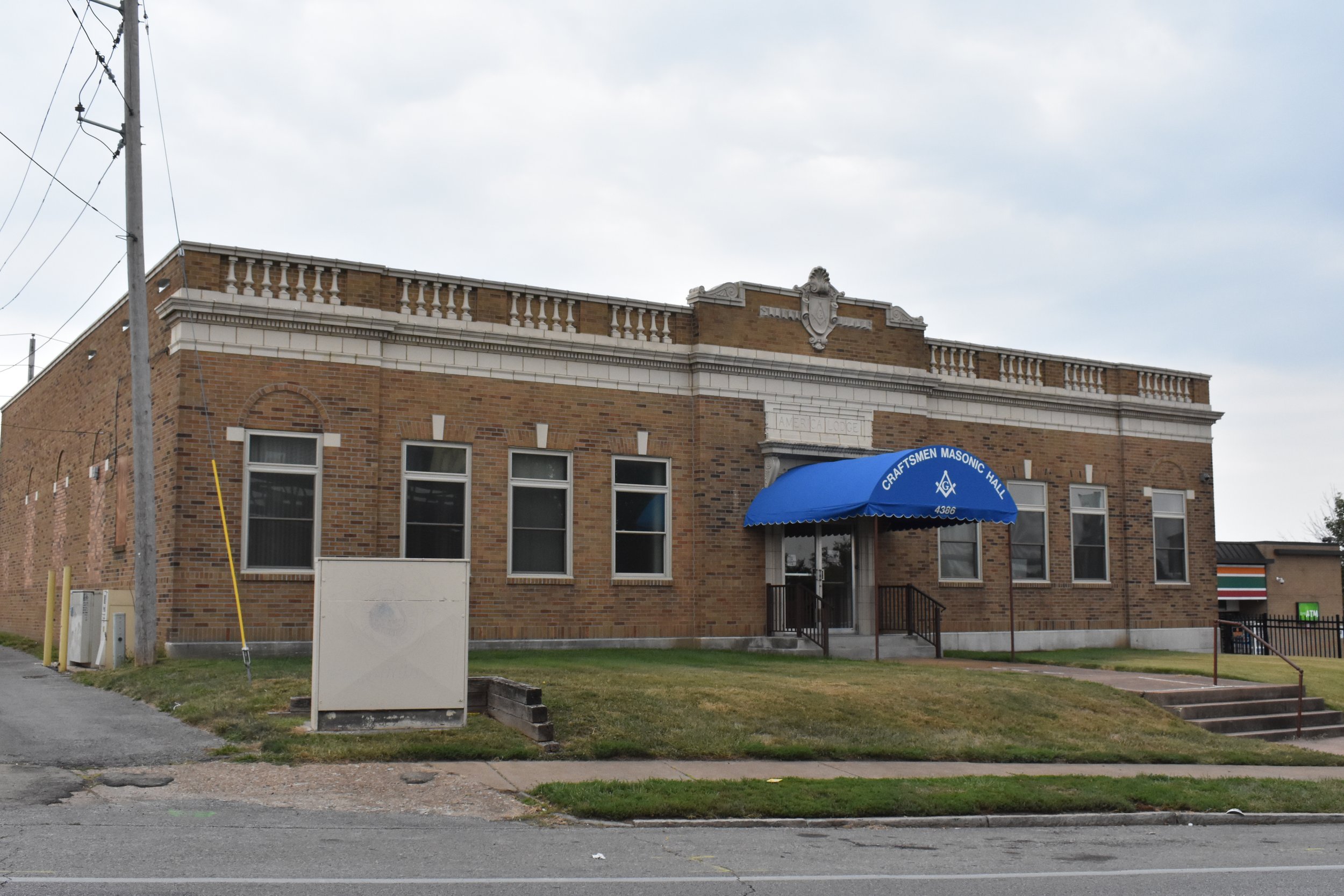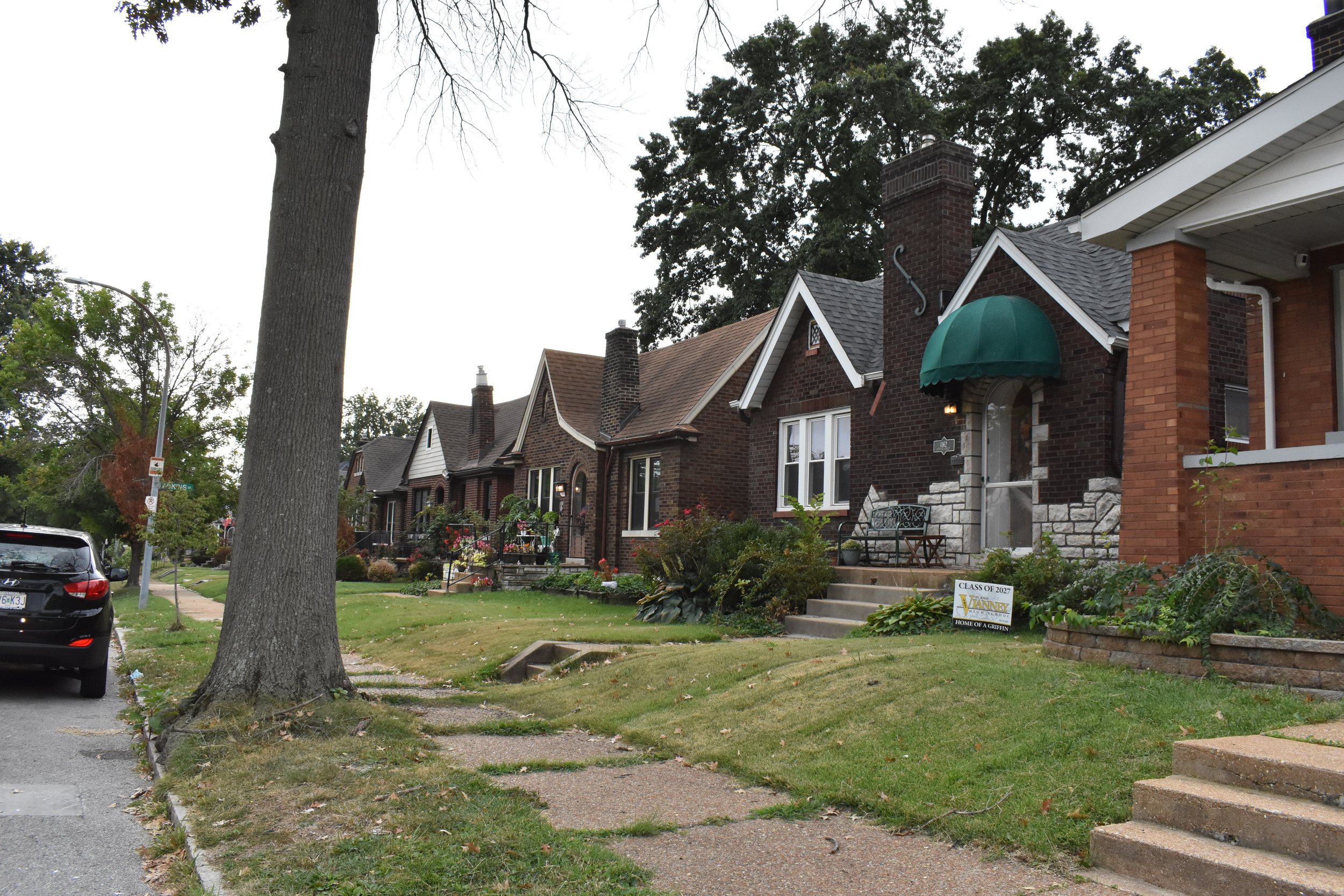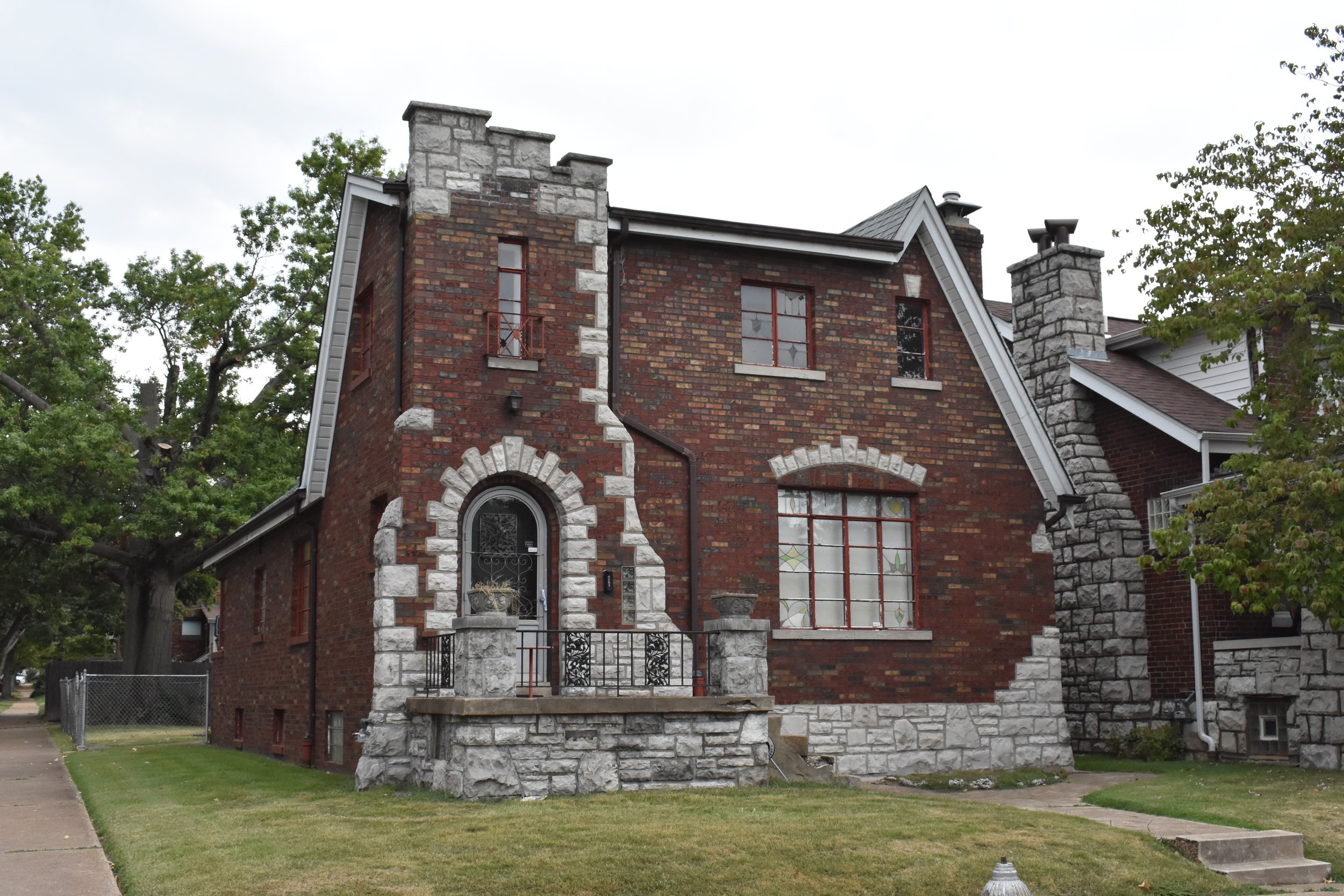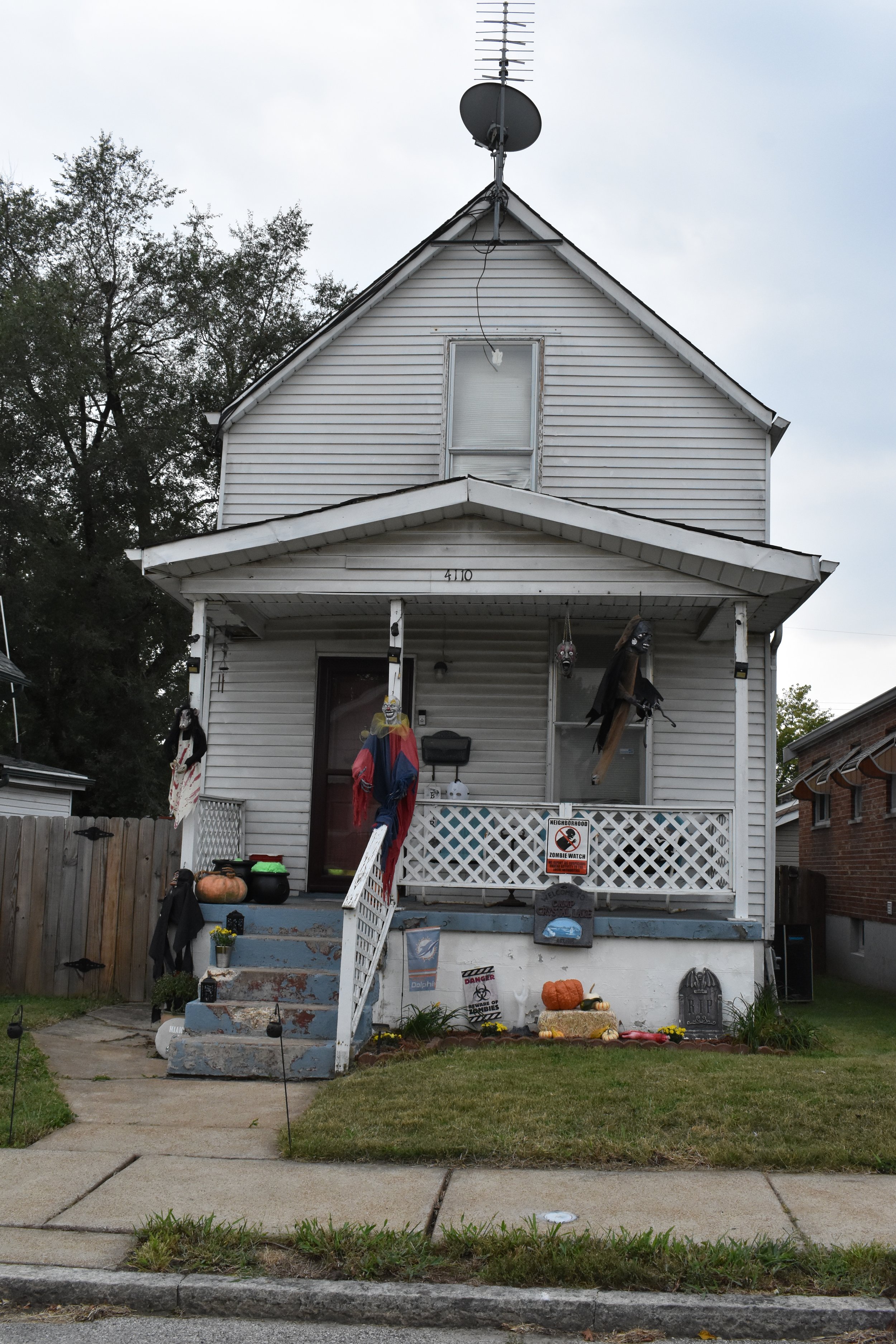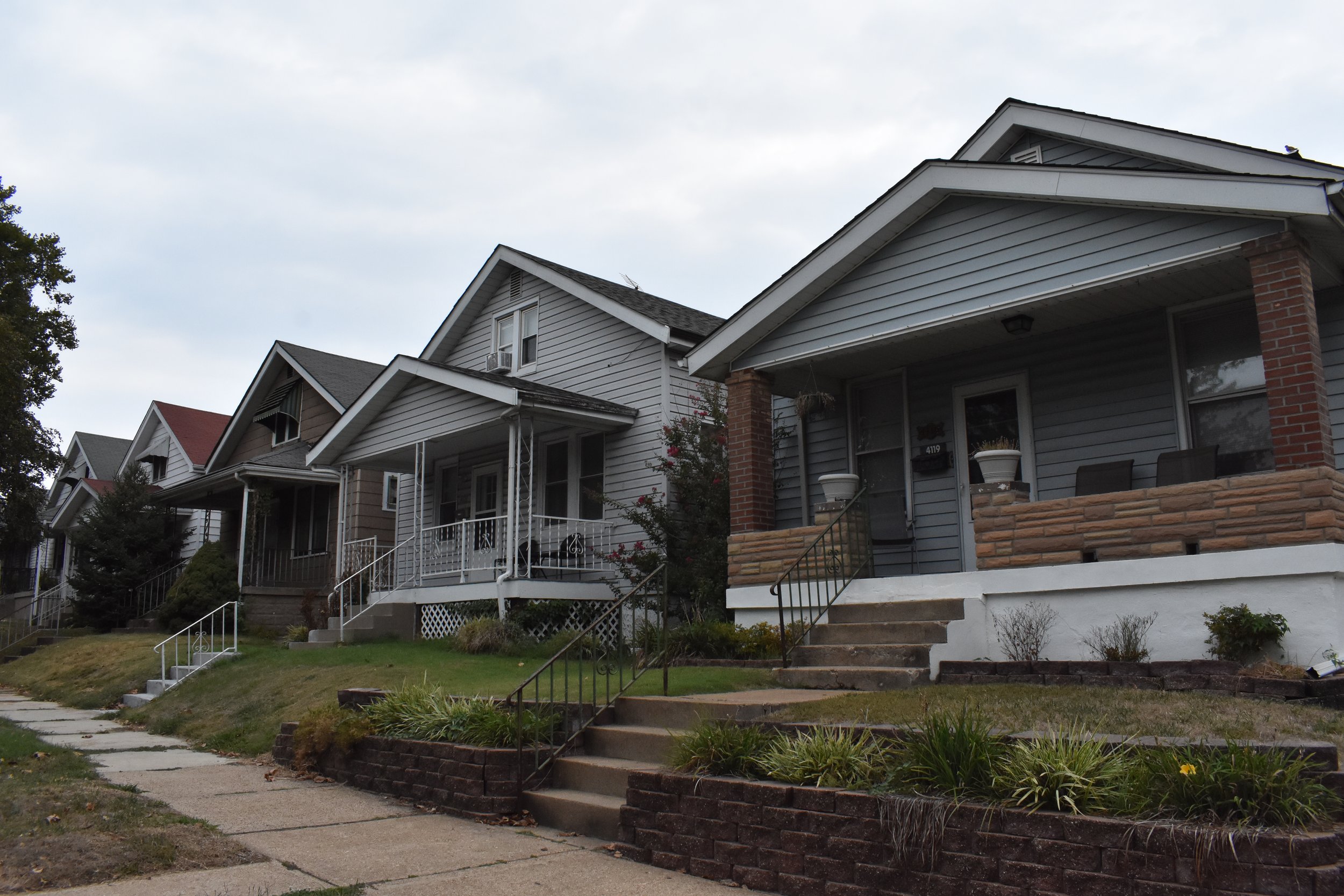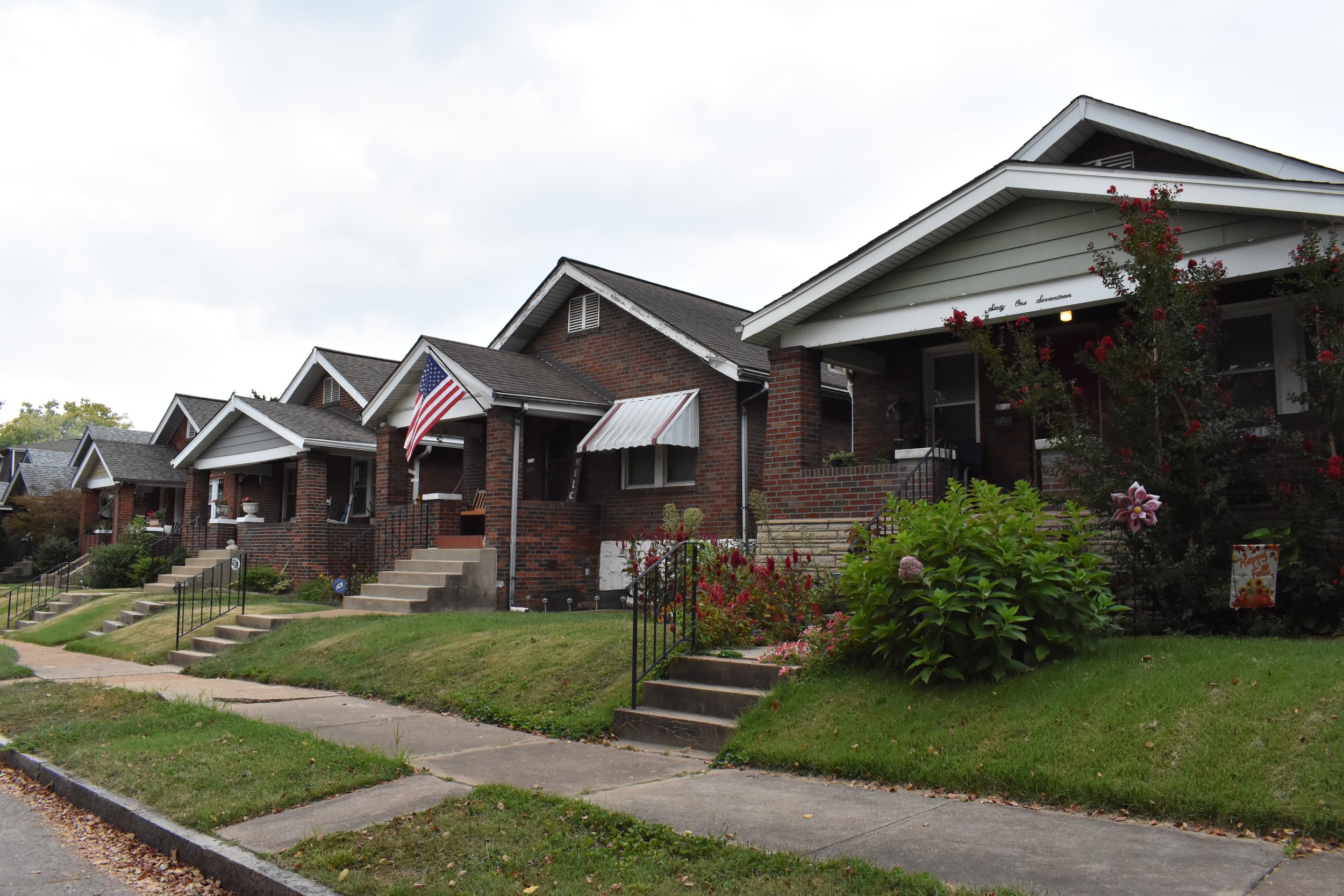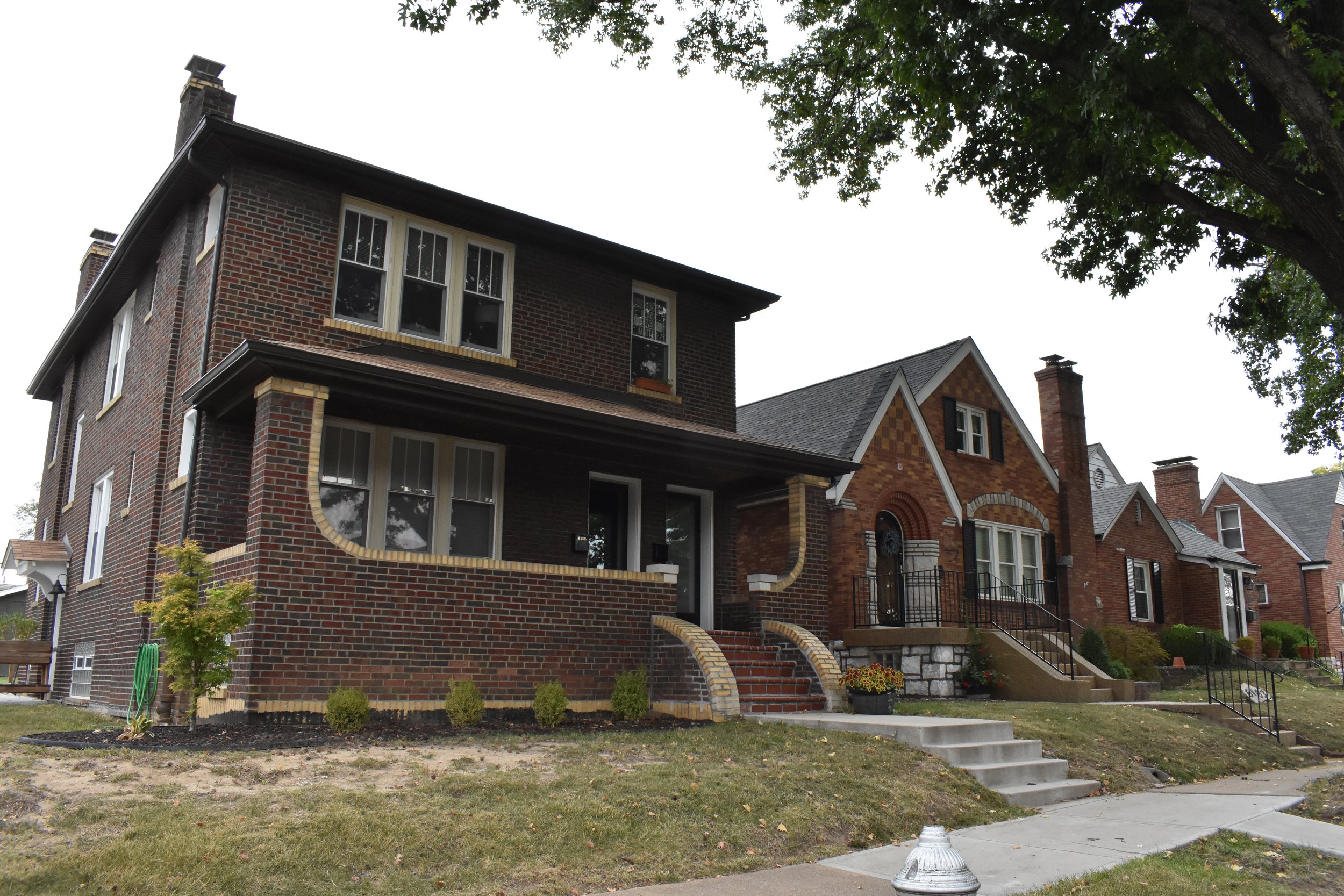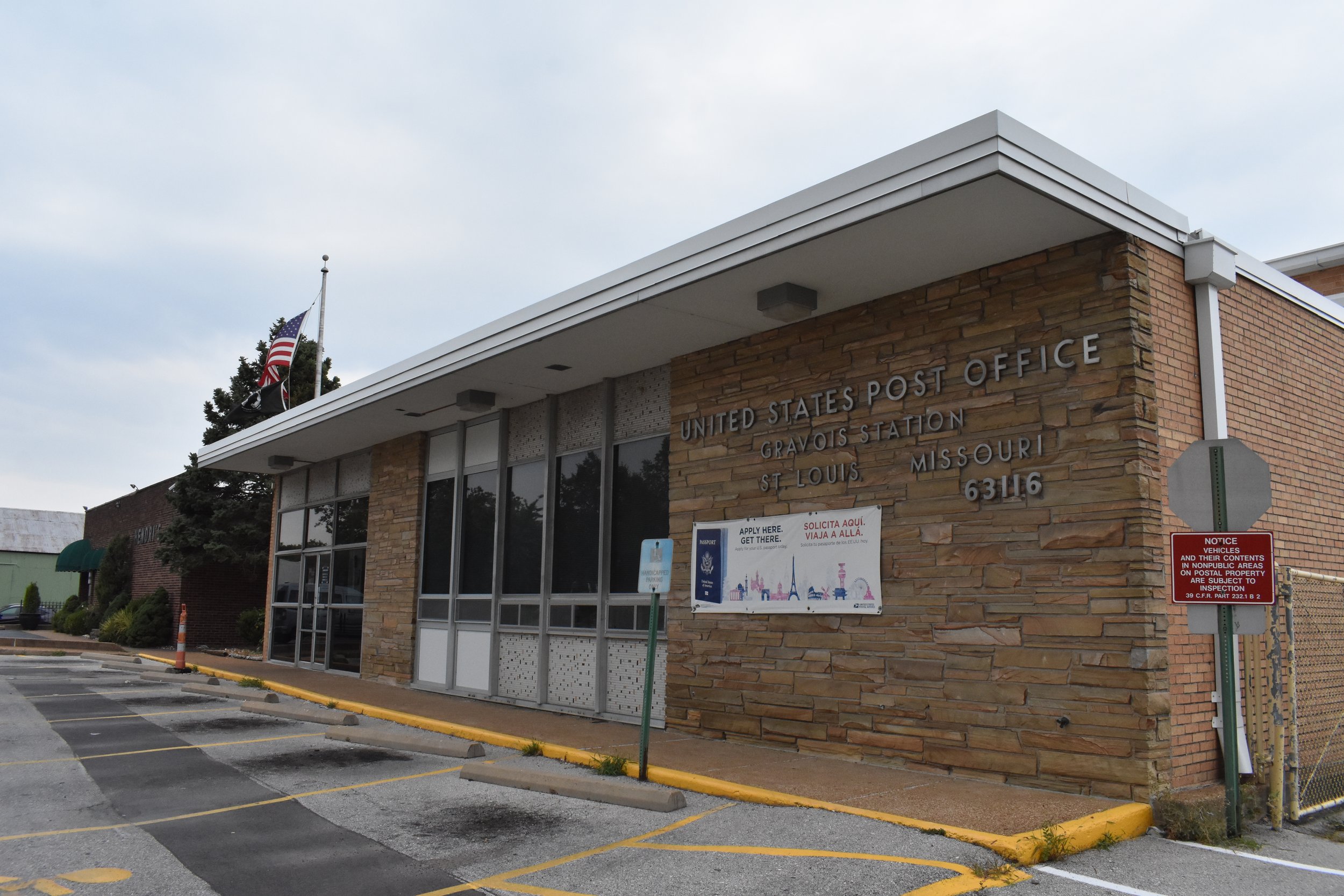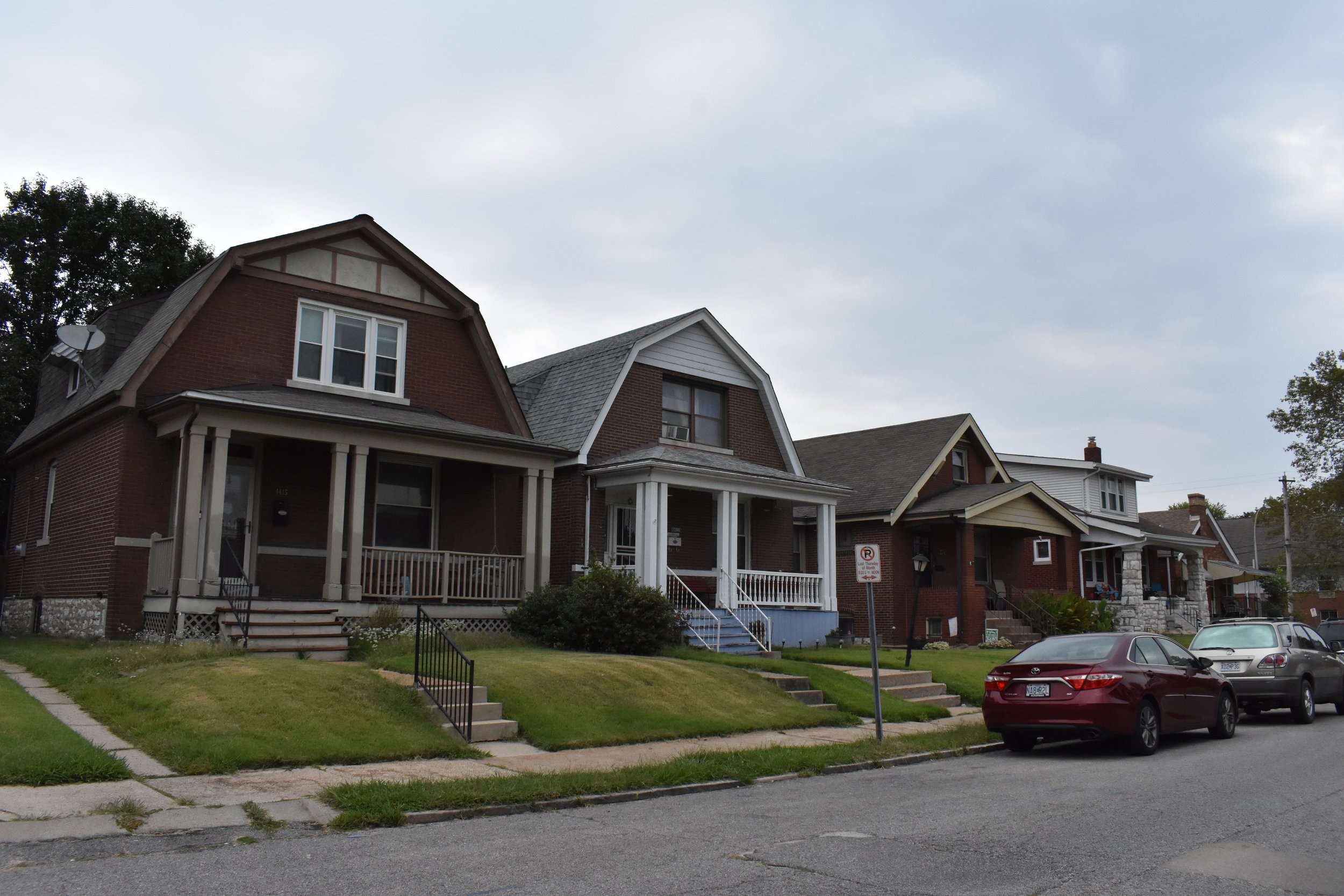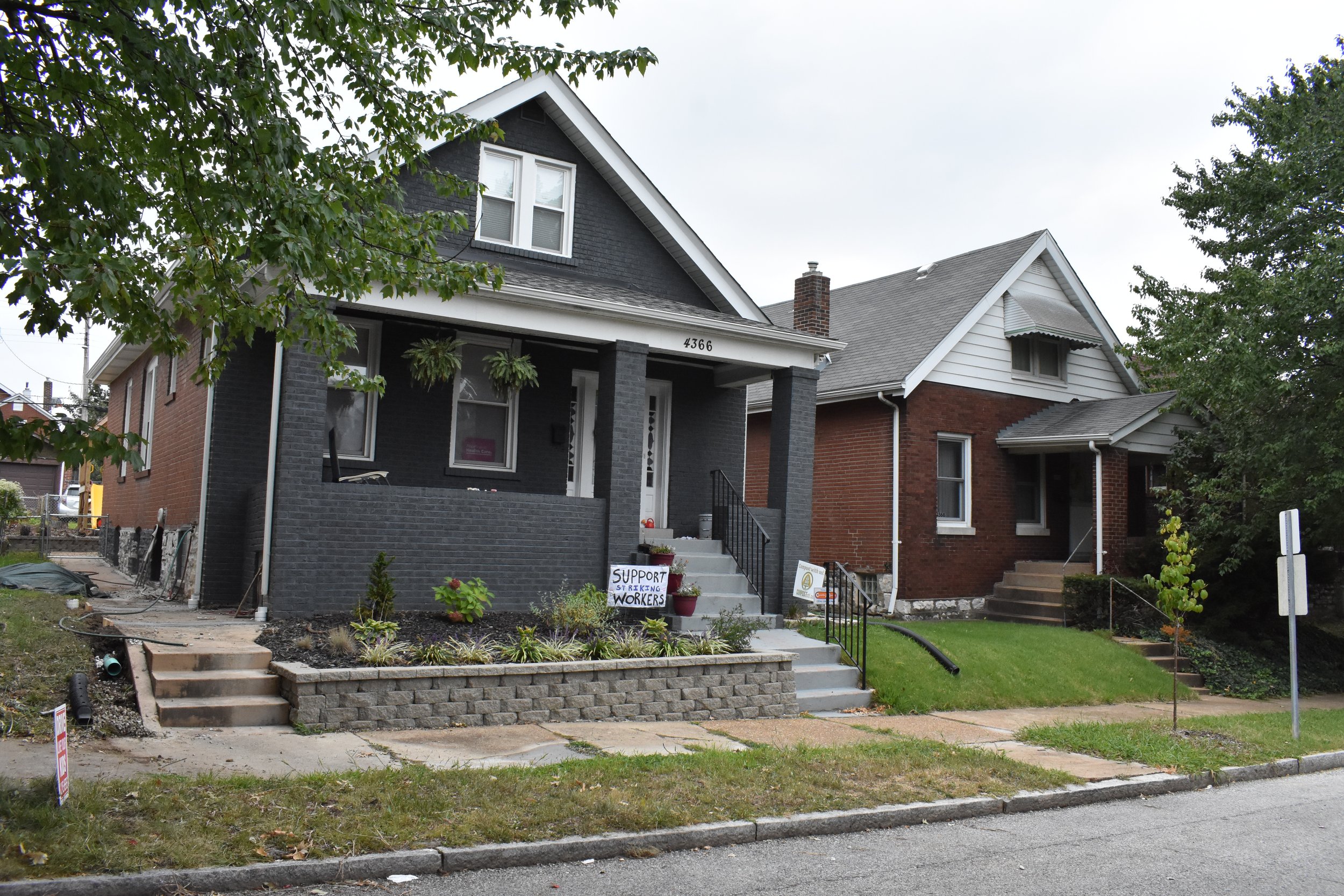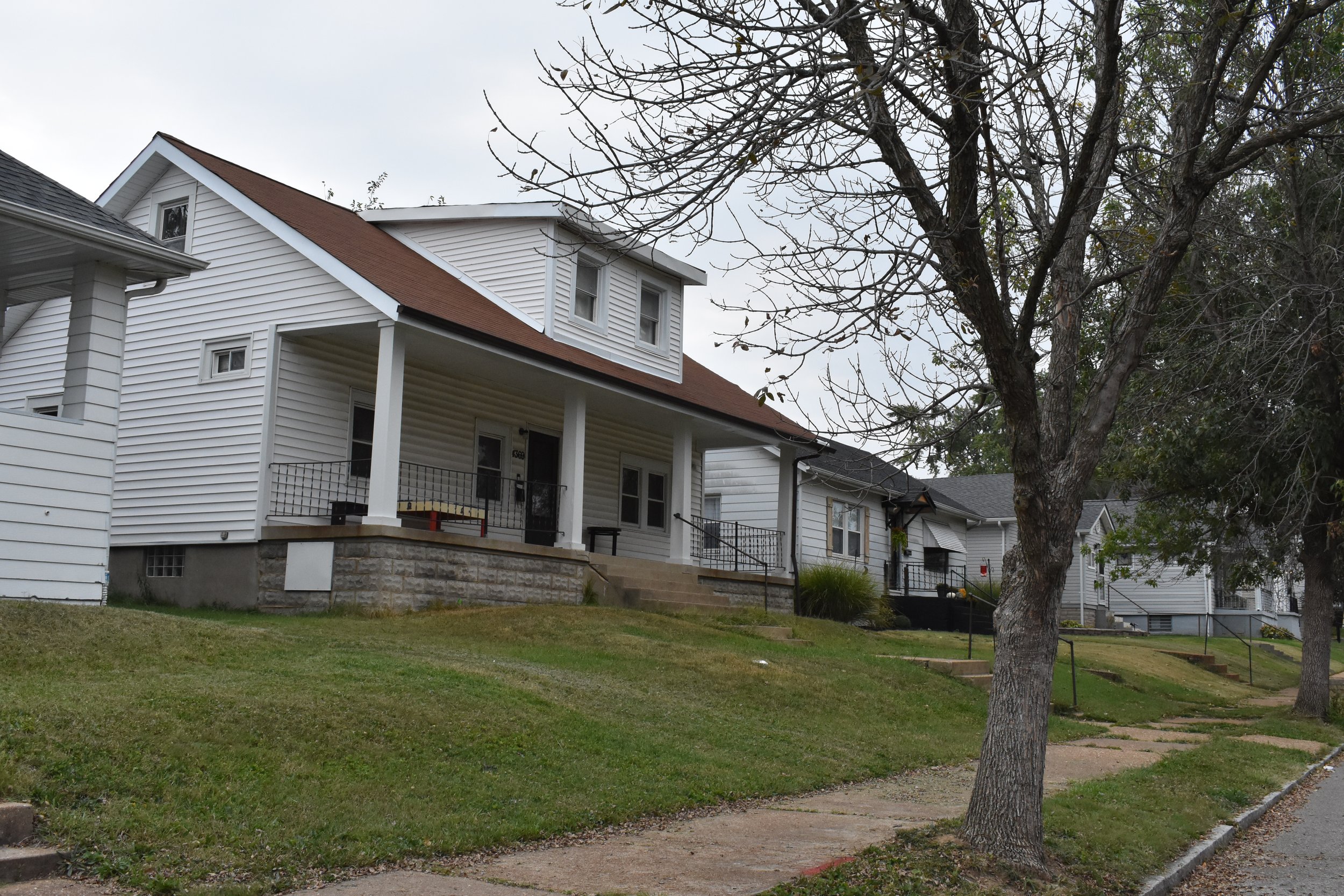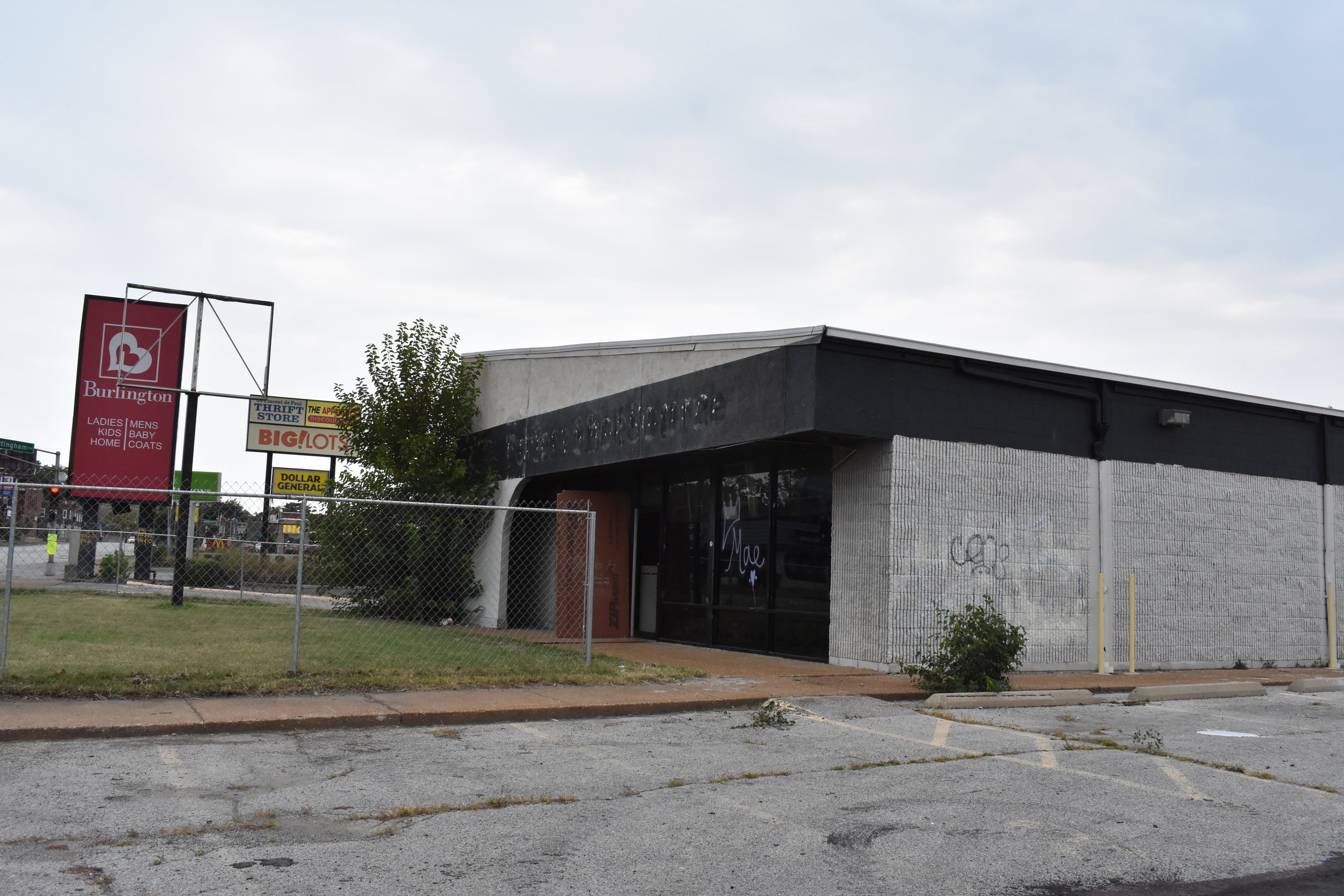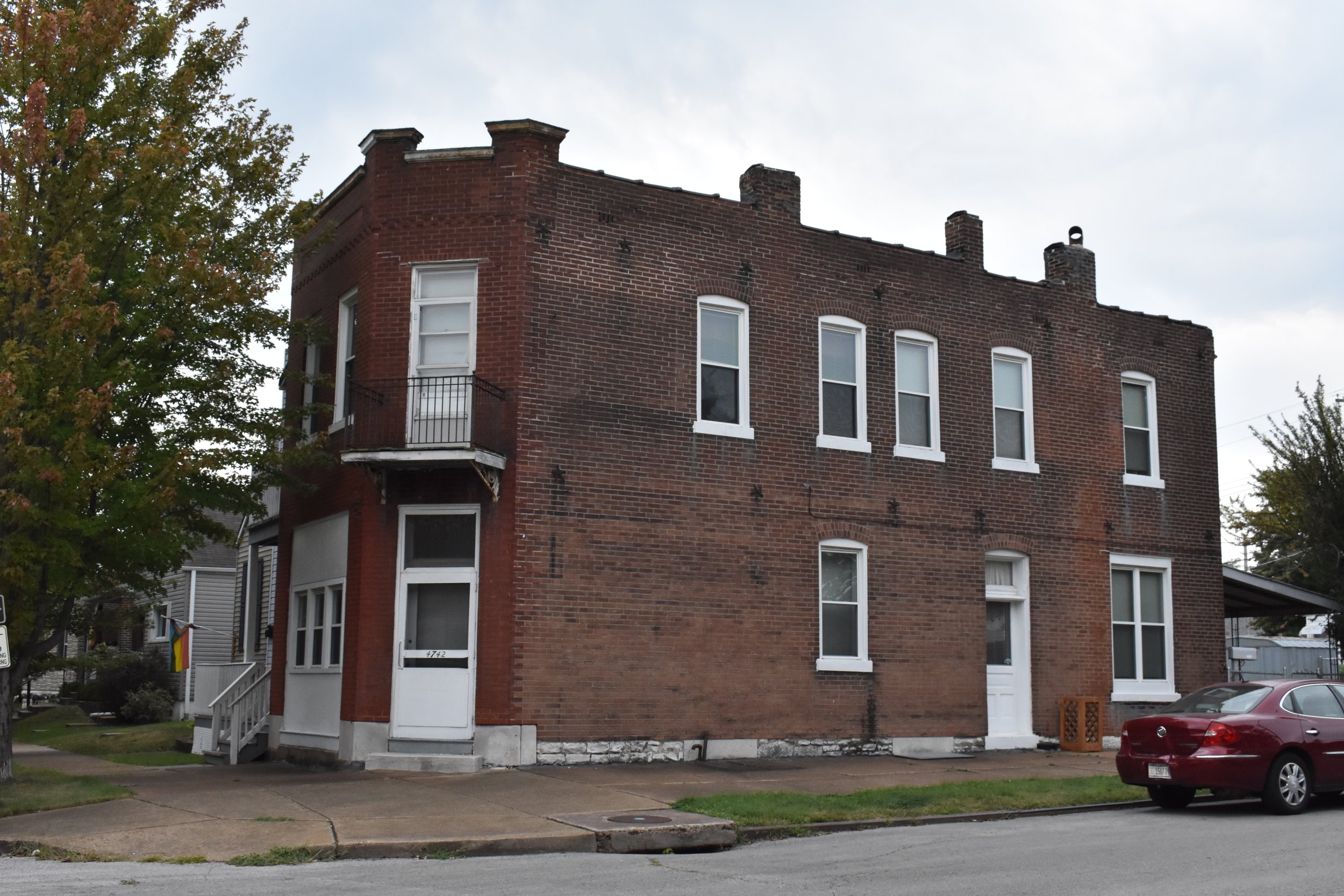Bevo Mill is a south St. Louis neighborhood bound by Chippewa Street on the north, Holly Hills Boulevard on the south, Gavois/Christy/Kingshighway Boulevard on the west and Leona Street and the MoPac RR tracks on the east and southeast:
As you can see from the map, there are two huge cemeteries and large parcels reserved for industrial sites (some still in operation) and suburban shopping centers. Another thing you might note from the above map is the heart of the neighborhood at the intersection of Gravois Avenue, Morganford Road and Delor Street....one of the most beautiful intersections in the city.
Bevo had a 5% increase in population from 1990 to 2000 when 13,319 people were counted: 83% white, 9% black, 4% Hispanic/Latino, 3% Asian. Yes, you read that right, Bevo Mill had a population INCREASE from 1990-2000. This is almost unheard of in the city during that time frame. This increase was largely due to the early 1990s influx of Eastern European immigrants, mainly Bosnian, Croatian and some Roma. Of the 5,984 housing units exist in Bevo, 92% are occupied of which 64% are owned, 36% rented. The good news was not sustained in the timespan from 2000-2010 where a 5% resident loss was observed with racial shifts as well: 74% white, 14% black, 8 % Hispanic/Latino and 4% Asian. From 2010 - 2020, Bevo took a beating losing 6% of its population. The racial breakdown is now 58% white, 21% Black, 12% Hispanic/Latino, 5% Asian and the remainder being mixed race and “other”.
In a city that is largely binary white/black, Bevo remains very diverse by St. Louis standards. Occupancy remains strong at 91%.
If St. Louis is to ever succeed and turn the tides of massive, staggering population losses decade after freaking decade, it will need an influx of immigrants that will save us from declining population numbers. I have a lot of first hand experience with Bevo, as I lived around here for nearly 10 years. Bosnians are saviors of the storefronts along Gravois. There are countless restaurants, coffee bars and watering holes along here. I learned of Eastern European food here and I am forever thankful for the Bosnian influence in St. Louis. These are great, hard working, honest people. Were it not for Bosnians, it would be nearly impossible to get fresh, artisan bread (kruh) and Eastern European delicacies in St. Louis.



I am however sad to report that the good news of population gains for Bevo Mill ended with the 2010 count as Bevo lost 5% of its population. Why you ask? Here's one reason: Bosnians are moving to South County and beyond at. staggering rate.
Bevo Mill is largely clean, well kept and tidy. Sure the houses are on the smaller end, but overall, a drive through the streets of Bevo Mill would certainly not lead one to believe this is one of St. Louis' fringe or even scary neighborhoods. It's just not. It's a great place to be. It's a fascinating, beautiful place. Luckily, there are still enough Bosnian-American's here to feel their presence and hear their language and smell the cooking from the kitchens and restaurants. There are also a lot of multi-generation Bevo-ers here to make it feel like a stable place, a decidedly south city place with a new spice from abroad. It's south city through and through.
The city has missed a major opportunity to brand Bevo Mill as "Little Bosnia". The area immediately around Gravois and Morganford should be a destination place and advertised and branded and elevated as much as the Hill is for its Italian-American heritage. Where are the street banners? Where is the support? Why isn't this a regional draw? Because the city isn't proactive about immigration and ethnic enclaves. Also because many of the old timers aren't as happy about the 1990s wave of immigration. To them change is bad...any kinda change.
On to the amazing place that Bevo Mill is...and it is one of South City's best. The neighborhood gets its name from the awesome August Busch mill at Gravois/Morgan Ford/Delor. This is one of 3 Busch family prohibition houses, including the Stork Inn on Virginia and the Feasting Fox building at Grand/Meremec. A little history (source):
During the years just prior to Europe’s involvement in World War I, August A. Busch, Sr. and his architects explored The Old World for examples of Flemish architectural styles. With his plan to build an authentic mill in his native St. Louis, Mr. Busch studied various construction methods of the Dutch windmills. When he returned to St. Louis, he chose the spot, in 1915, at Gravois Road and Morganford because it was approximately halfway between the Anheuser Busch Brewery and Grant’s Farm, his home.
Mr. Busch used the beautiful Mill Room as his private dining room for many years. The remainder of the restaurant was open to the public in 1917.
Complete in 1916 for the then-incredible sum of $250,000, the Bevo boasts quite a few unique architectural points of interest. The windmill is 60 feet in diameter and revolves on a 24 inch shaft extending through a marble bearing. Originally, the blades were wooden and propelled by wind. In 1954, the blades were damaged by a fierce wind, striking the tower. They were replaced by aluminum blades and are now electronically operated. The exterior of the building is finished with specially selected stones of all colors, shapes and textures, personally gathered by Mr. Busch from Grant’s Farm, and set in stucco.
Following the German and Dutch tradition, a pair of storks were mounted on top of the chimney to ensure good luck. The vaulted ceilings of the foyer and Mill Room have groined arches which end in stone-carved gnomes, unusual in design and character. The gnomes were exhibited at the Paris Exhibition of 1898 and cost and additional $50,000.
This southsider is proud to have had many experiences here, some wholesome, some strange, some Twin Peaks-like surreal. I love this place and it's a shining gem in our architectural and cultural crown. Check this joint out:






On to the commercial stretch of Gravois in Bevo... It's one of the least messed with commercial corridors in the city. It's relatively contiguous with urban scaled buildings of all shapes and sizes. The suburban disasters that have occurred over the years (former Captain D's, Pizza Hut) are few in number and where these holes exist, many are filled with human activity like street vending and some of the fast food disasters which are nearly always temporary have seen new life as Bosnian restaurants.

Gravois Avenue in Bevo is a mix of seasoned south side places, Bosnian places and some new welcomed new comers jumping on board to make this a great urban strip:
















Morganford is also a point of interest in Bevo as it's continuous stretch of homes and storefronts make this area ripe for future development a la the Skinny Town area in Tower Grove South, South Grand, 14th Street, Washington Avenue, etc areas of STL:




Do you like pinball and X and the Clash on the juke? Check this joint out:

As Kingshighway is one of St. Louis' major north-south arteries, you'll recognize many of the sites along this thoroughfare that nearly everyone has seen, here are a few worthy of contemplation:



Everyone's got to head for the mountains sometime:

My proud Bohemian cousin would disown me if I didn't mention the American-Czech Education Center right off Kingshighway at Landsdowne, which hosts one of the best record sales in town:

There are some cool multi-unit apartments directly across from Christy Boulevard on the southwestern edge:


I won't document the numerous suburban eyesores that have descended upon Bevo in recent years. Nearly the entire northwest section of Bevo looks like Generica, U.S.A. complete with strip malls and massive, under-used surface parking lots. One classy building was spared in the clearing for the parking lots though and it's a real beauty, it's right behind the south side of the strip mall:



Another structure worthy of note in the former Venture/Frank's/Office Depot strip mall is visible to the left in the next frame:

That's a minaret, an architectural feature of Islamic mosques. These have been around since the 8th Century. Uh, yeah, like 80 years after Muhammad's death. Frame it now, that's about the time when the Mississippians were thriving over in Cahokia. That's some amazing stuff. And true to St. Louis' recent history of surface parking lot lust-at-all-cost, we have here in Bevo our most prominent example of this holy monument right in the middle of baking, vacant asphalt. A strange dichotomy if you ask me. All that aside, I am glad there is a place that Bosnians and other religious Muslims can get their worship on in my beloved South City. It really is a striking monument:


There are many other places of worship in Bevo, including the former St. John The Baptist church and former high school, recently abandoned by the Arch Diocese in May, 2008:

And my favorite pastoral Lutheran church on the south side, right at Leona and Holly Hills:

Schools of Bevo Mill:



Several watering holes exist in Bevo, too many to show them all:


^It'll always be Dino's Bungelow to me....
Industrial sites of merit both passed and present:










Ghost and metal/neon signs of note:


I mourn the fact that the Trautwein's Shoe Store sign was recently taken down. It was one of my favs in the city and am crushed that it's gone and I didn't get any pictures. Thank goodness there are others that have documented it, so all is not completely lost.

So, you've seen the commercial areas and industrial areas of Bevo, next are the residential scenes. Bevo Mill is largely working class, clean and tidy South City humble homes:













There is a stretch along Bates Street between Morgan Ford and about Leona where the neighbors get together and informally go all-out during Christmas with lights and all other exaggerations of yuletide celebration, it's a site to behold and cherish:

You'll also see some larger homes near Holly Hills Boulevard and Leona on the southeastern edges:





Check out the art deco lights on this classic along Leona:

How bout those STL Dutch Colonials?



The rental to owner ratio is nice and the multi-fams are mixed in well:


The most unique thing...um, other than the big Dutch windmill right smack dab in the middle of Bevo...is the amount of jagged contrasts of building setbacks mixed between both homes and storefronts. I'll leave you with some that stood out to me today:





Check out this used video game store, a handsome storefront in the middle of a residential area:

And my favorite coffee roaster in town:

And an example of the rare, but personally beloved alley-facing homes of STL:

And then some miscellaneous stuff:





I straight up covet this ride:

Bevo Mill is a great, ethnically spiced area of St. Louis. It's one of St. Louis' greatest and most under-appreciated areas. Go get some Doner-Kebob, Sarma, Burek, Cevapi, Sirnica or Zeljanica and celebrate the unpretentious, real scene that exists in Little Sarajevo....oops, I mean Bevo Mill.
Misses on Original Tour
Not too many, but I will say some of the photos technically fell outside the official boundaries of the neighborhood. For that I apologize, as accuracy is a goal of mine with these posts. But, I won’t correct that as it is documentation of my continuous learning related to my home city. The zigs and zags of the neighborhood boundaries, along with the RR tracks make this one a bit disorienting to stay grounded.
Anyhow, not sure if it was a miss, but by 2011, the Peter Matthews Skate Park on Morgan Ford was well underway in its planning phase and I missed photos. So I’ll fix that here. The Kingshighway Vigilate Transitions group of skaters got the land from the LCRA and designed a skate park and a Florida skate firm provided the installation and build out upon agreement that the land would be free and the local groups could provide to volunteers to help with the build and maintenance. (source) Now that is community at work.
The place is still going strong.
While I mentioned Dutch Colonials, Bevo is one of the best neighborhood in St. Louis to find these charming homes. There are blocks that are almost exclusively made up of these treasures.
Not a miss, but I failed to mention the amount of sidewalk/street facing front doors, not unlike the Hill or big East Coast cities. They are all over and are super cool. I also failed to mention one of my favorite corner sliver buildings that would be one of the coolest taverns in all of St. Louis.
There is also a Sebilj monument that is a replica of one in Bosnia to honor the once strong, now faded impact of the Bonsian/Croatian/Mesopotamian/Roma immigrant influence of the late 20th/early 21st Century on Bevo. It is a bit, well, abandoned feeling, but still fairly maintained.
Noticeable Changes
It’s truly amazing following American immigration. Nearly all the Bosnians and businesses I mentioned are gone. The vast majority are “movin on up”, meaning work their asses off to get money…and in this case, move to the burbs. Bosnians largely moved to the many cities and areas in South County. They up and left. You won’t feel their presence, smell their food, see the shoes on the front porches…they are gone. Of course, some stayed, but the vast majority took off. You will still see businesses, bakeries and restaurants here, but they are in fewer numbers. Whenever given the chance to ask a Bonsian American why they left St. Louis the answer boils down to the exact same reason previous generations left, race/culture issues, and desire for a massive yard. So it goes, the American story, I suppose. Me, I thank them for the vibe they brought to St. Louis when I lived in this part of town. It was a different place then, and I was happy and grateful to experience that. You have to go to South County suburbs to get that critical mass vibe these days.
Other noticeable changes include some new uses for the aging, long shuttered factories that employed the immigrant populations here. Look no further than the Alligator Oil company which I posted on in the Additional Reading section which is slated to become a charter school. What that means is it will be rehabbed for the good of us all and will become a school that will close if it doesn’t get a diverse student/family population committed to their kids, education and neighborhood. Otherwise it’ll be shuttered or worse yet, corrupt and close.
There is a former machine coil factory that is slated to become a new home for stray rescue of St. Louis.
There is some infill and rehabbing going on, but it’s not like other more central neighborhoods of St. Louis. I noticed the exact same small home style that is sprinkled around Bevo.
There have been some quality additions in the course of the last decade that have improved the restaurant scene in Bevo. And of course Das Bevo, with it’s wonderful beer garden and outdoor stage booking tasteful local bands makes for a great summer night in South City.
Tim’s Chrome Bar had an unfortunate issue with their building and the classic metal and neon sign, I’m told, will be brought back to life.
The Silver Ballroom is a South City gem that has added Tiny Chef a 100% top shelf Korean kitchen that offers affordable, killer meal at a non-pretentious old school tavern like pinball joint.
I know I shouldn’t mention businesses because they come and go, but I if you want to support lovely people and hard working people trying to make spaces for people, please visit Eni’s Pizza, Novella Wine Bar or Fonda La Poblanita. Non-pretentious, legit, solid people here. Lovely families who immigrated here and made good.
For all you World Wide Magazine fans/weirdos, you can grace the former Dino’s Bungalow which is now called the Stellar Hog, another quality family joint that books local musicians and has wonderful food and patio for no nonsense neighborhood vibes.
Any finally some photos to show how the neighborhood looks as of publishing.
What Are The Future Needs?
As goes Bevo, Dutchtown and Carondelet/the Patch, so goes South St. Louis. The future will tell what happens to St. Louis way more in these areas than the North St. Louis neighborhoods that continue to bleed Black residents with little to no investment nor gentrification/blending of races/incomes/cultures.
There has been incredible speed hump investment all over Bevo to slow the no-dignity idiots driving too fast in neighborhoods. The investment needs to continue lest we see the neighborhood decline. Sidewalks, street resurfacing, low-interest small biz and home owner loans to improve their properties is highly needed in these parts. It would go a long way to beautification and dignity for a beautiful neighborhood.
First of all, Kingshighway is an absolute mess of post-suburban blight. The horrible shit shacks built to temporarily house chains that will eventual close and get crushed by online commerce have left us with some hideous remains of suburban ideals that destroyed our beauties and now sit empty.
The news isn’t all bad though, there are plans for a mixed use housing building where the former Missouri National Guard facility was. It is ready for investment and groundbreaking.
And Garcia Properties, who many believe are a modern savior of the cool old buildings on Kingshighway and the former YMCA building have invested and continue to invest to make this stretch of Stroad more city and less suburban flyway.
And with all truly South City neighborhoods, this place could open more corner taverns and businesses. They are needed and are sitting there just waiting for new uses.
Additional St. Louis City Talk Reading
Delor Street Improvements - July, 2009
The Silver Ballroom - May, 2010
Joseph Leisure Park - July, 2014
Bosnian Culture - A Blip On The St. Louis Timeline? - January, 2019
James Earl Ray - St. Louis Connections - April, 2020
Alligator Oil Clothing Factory - October, 2021


